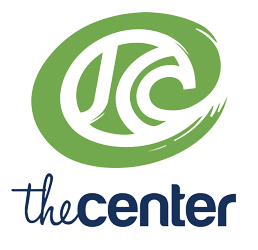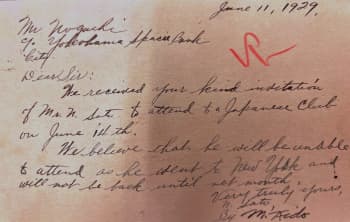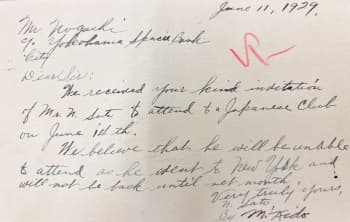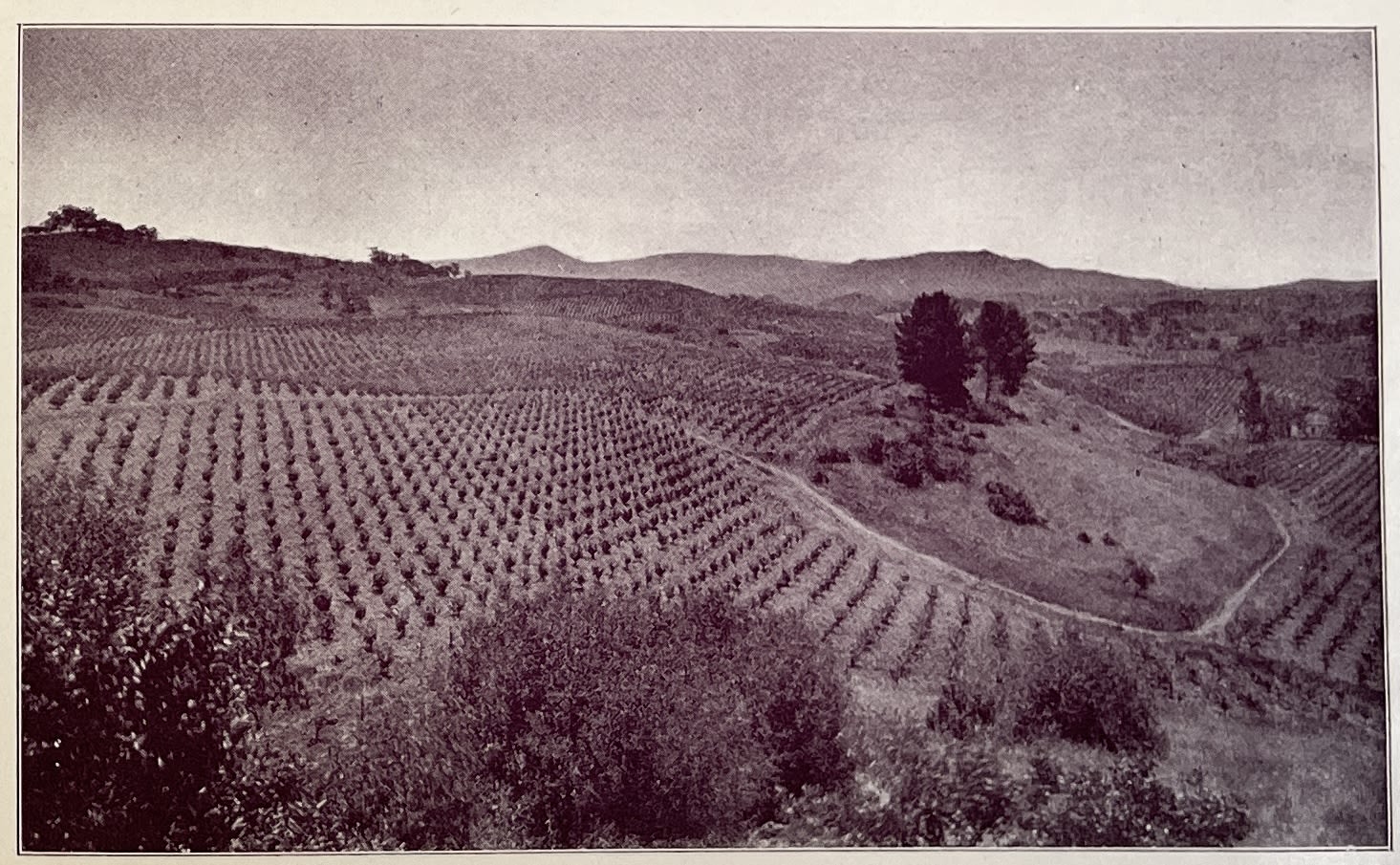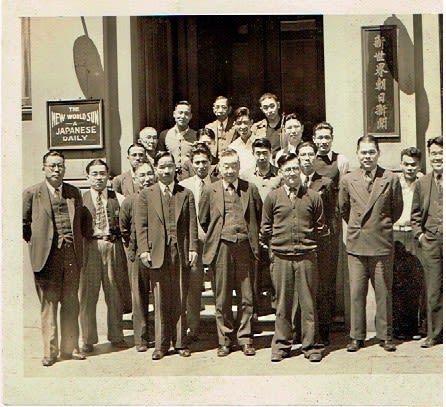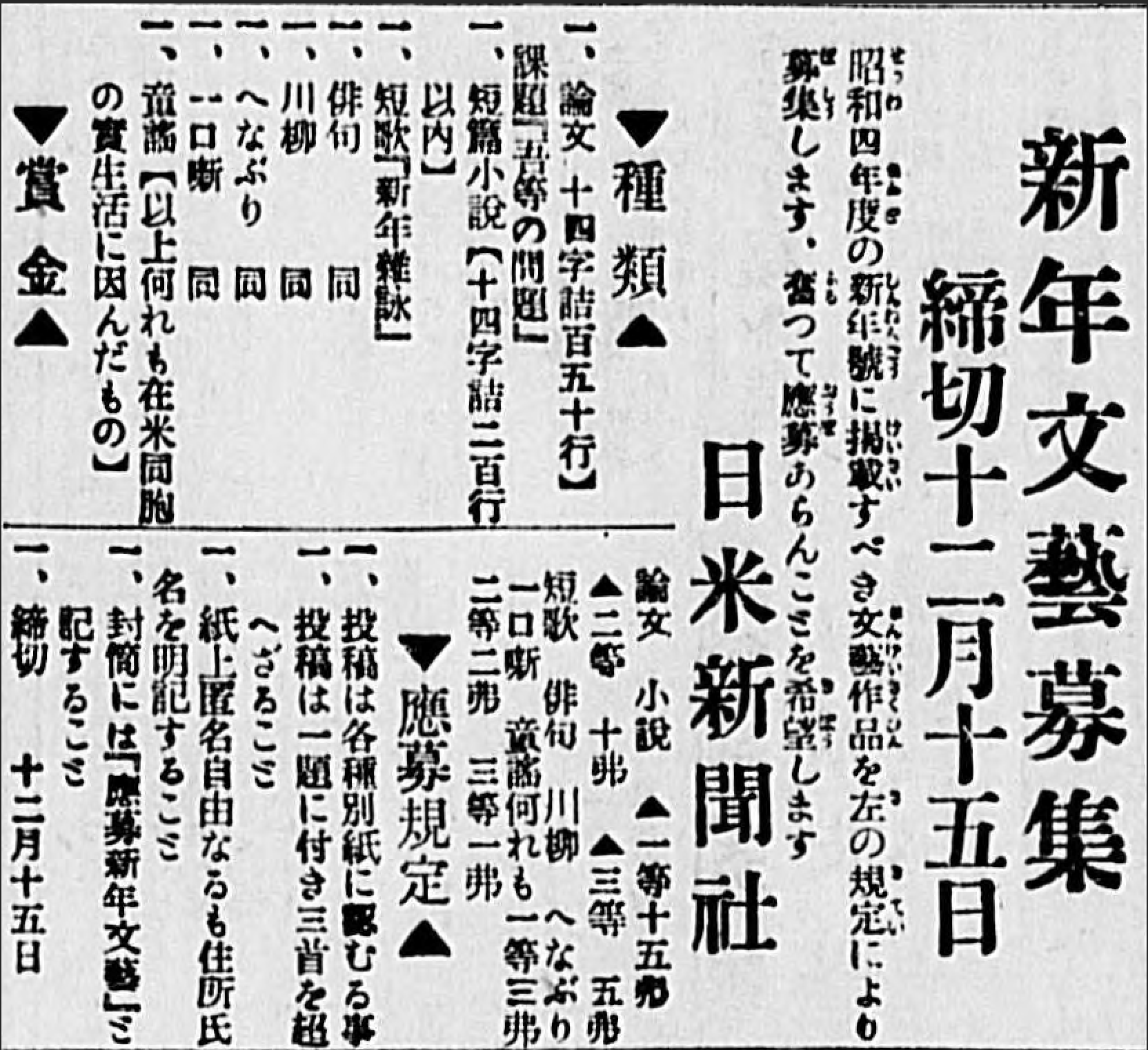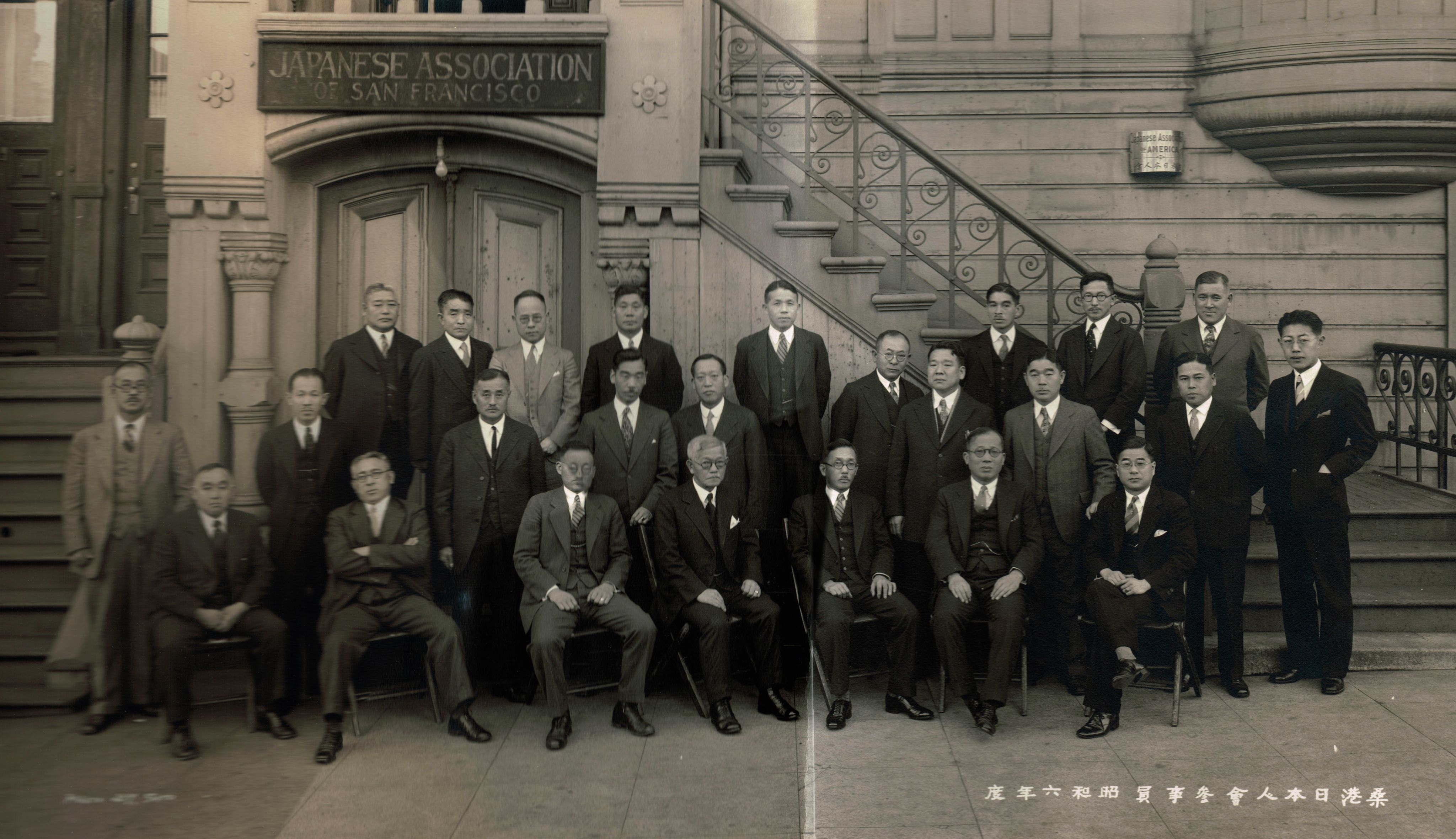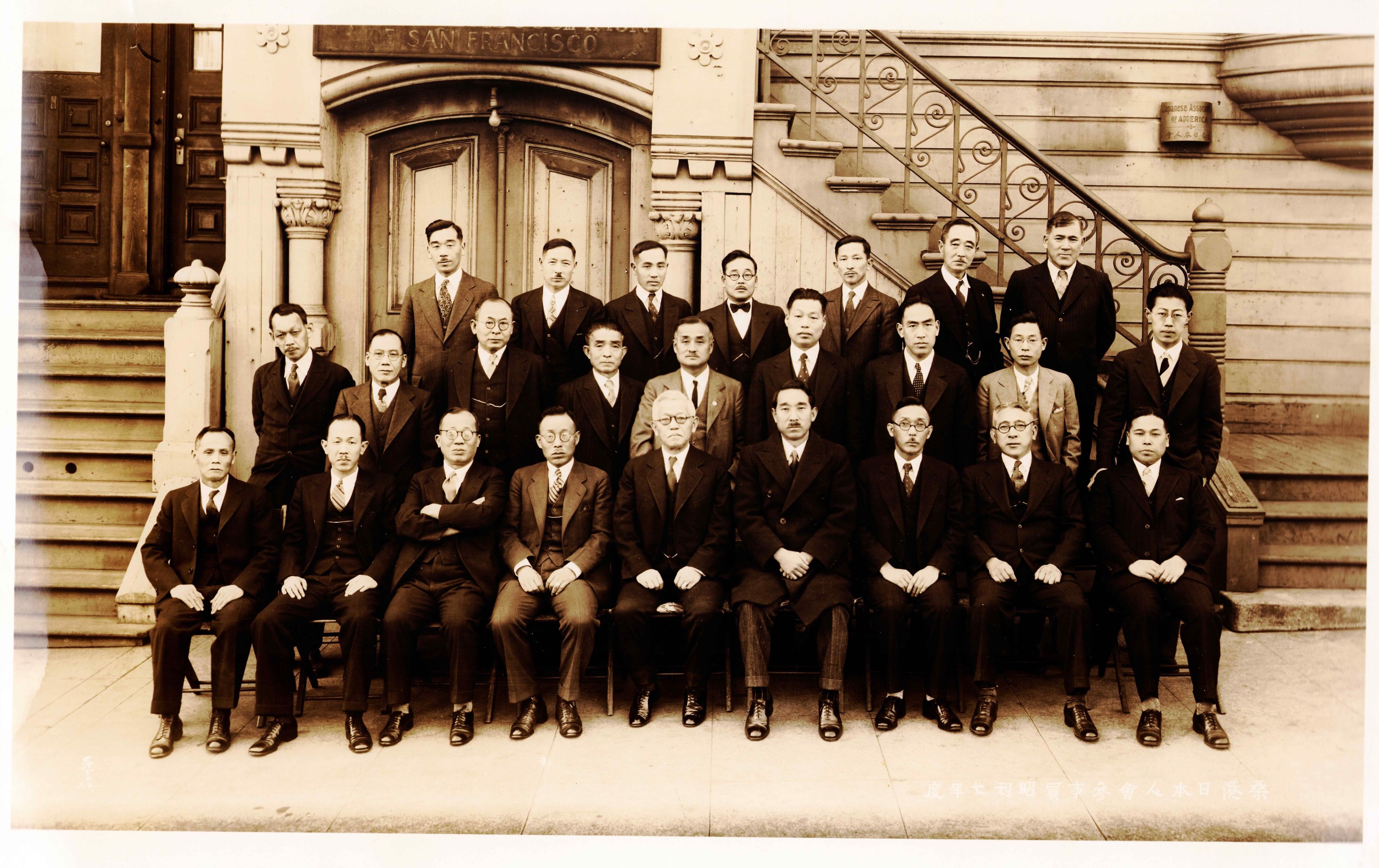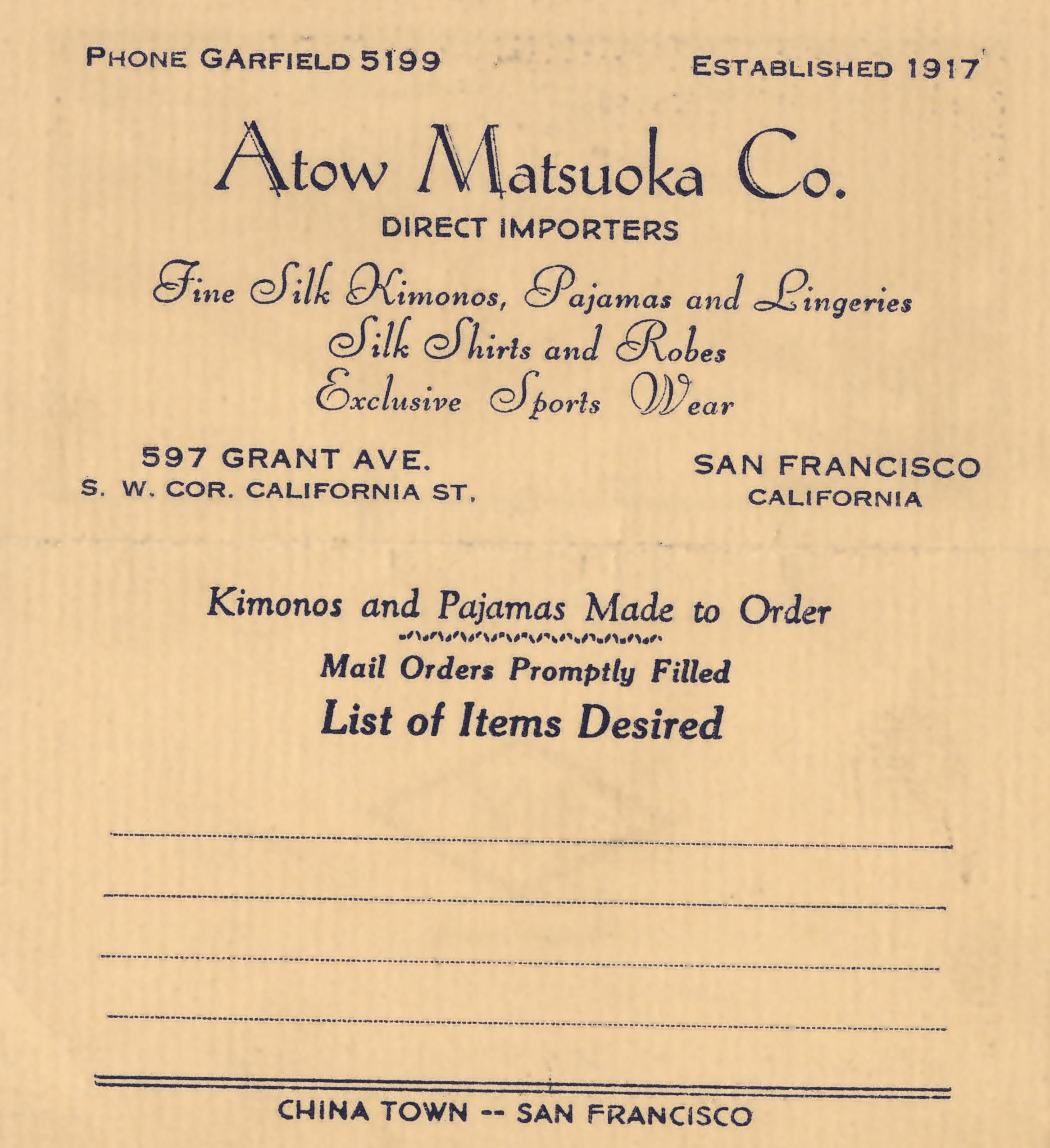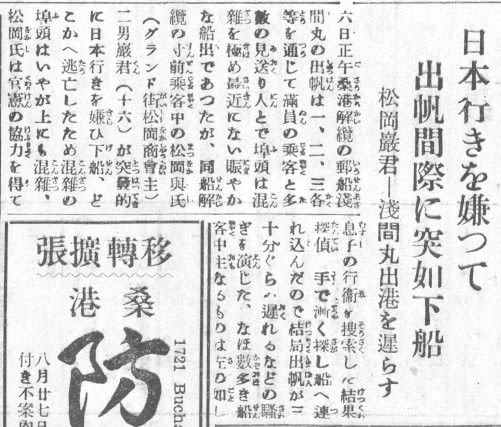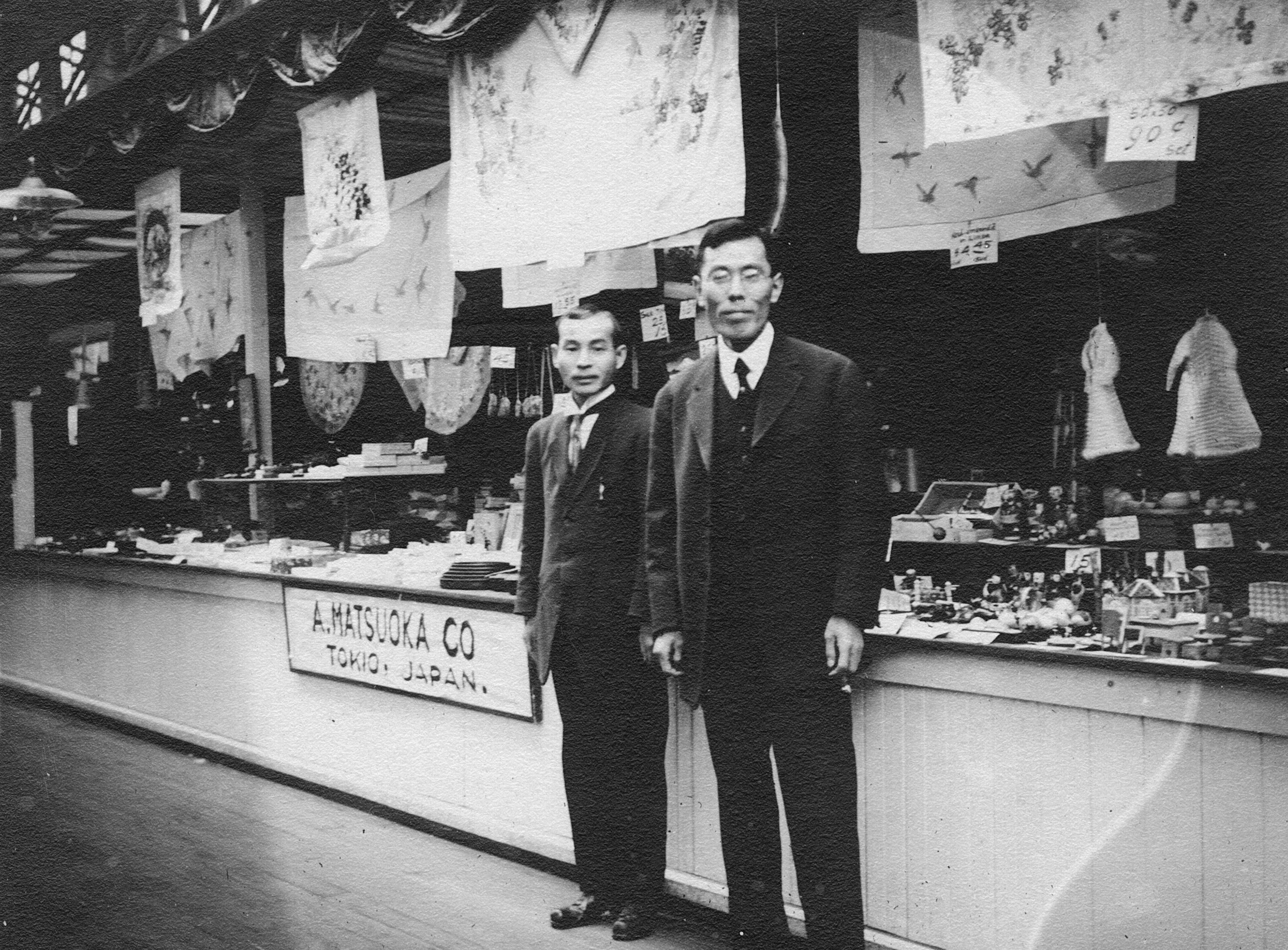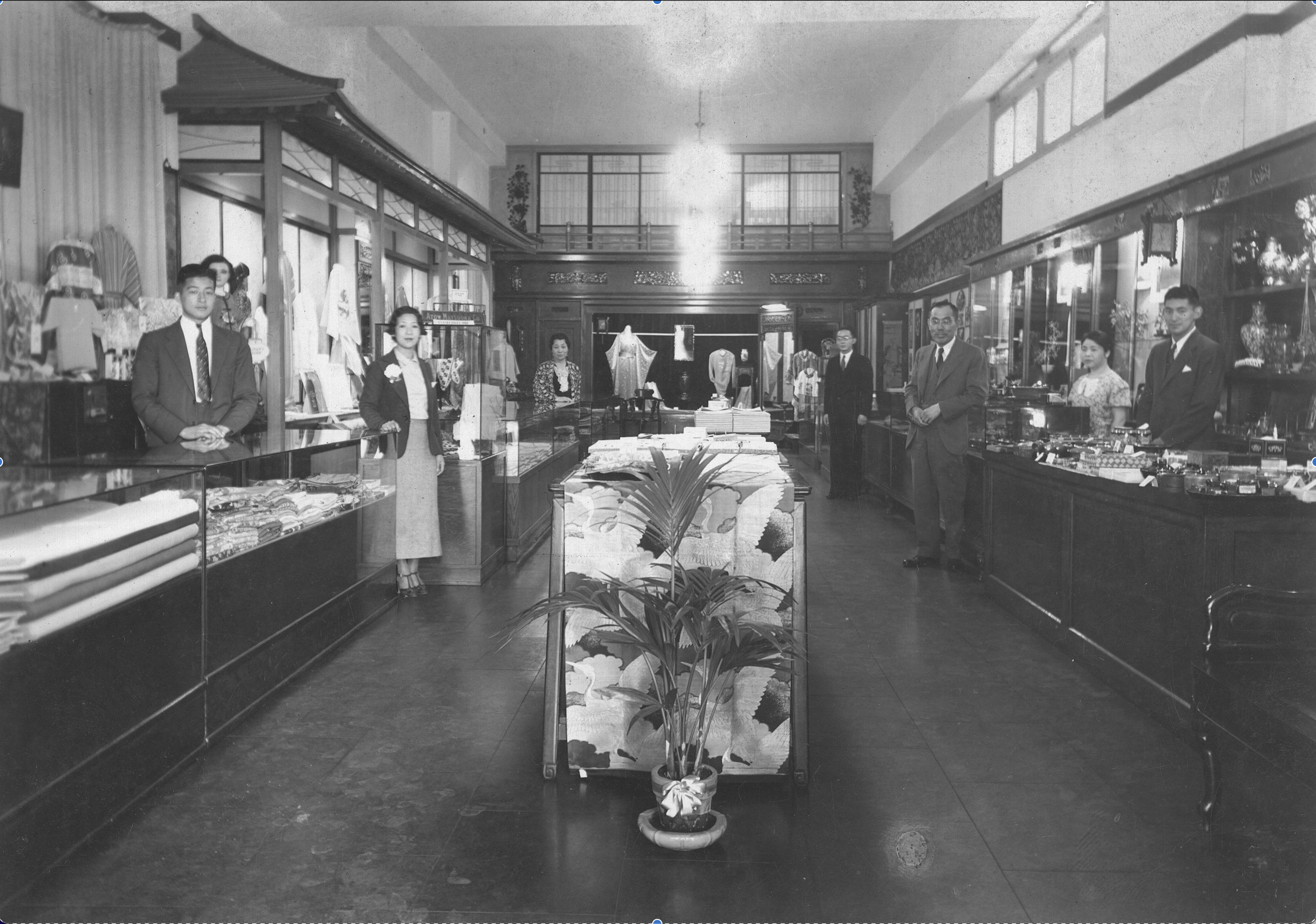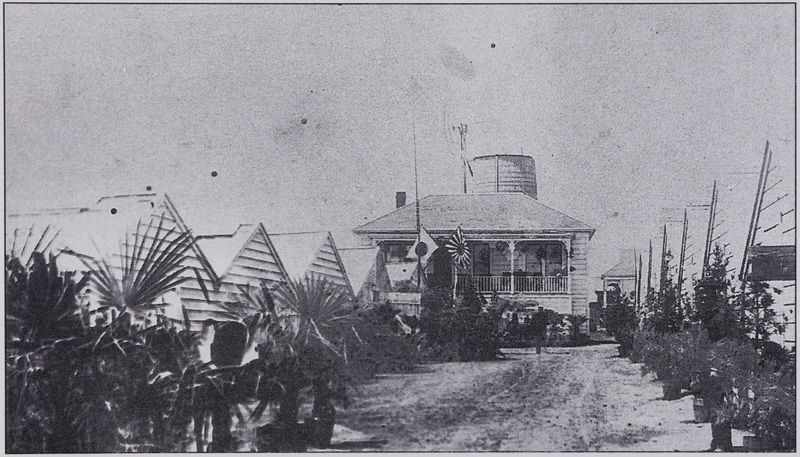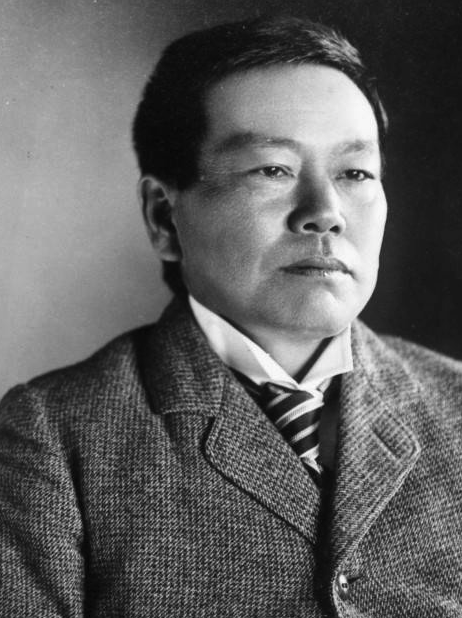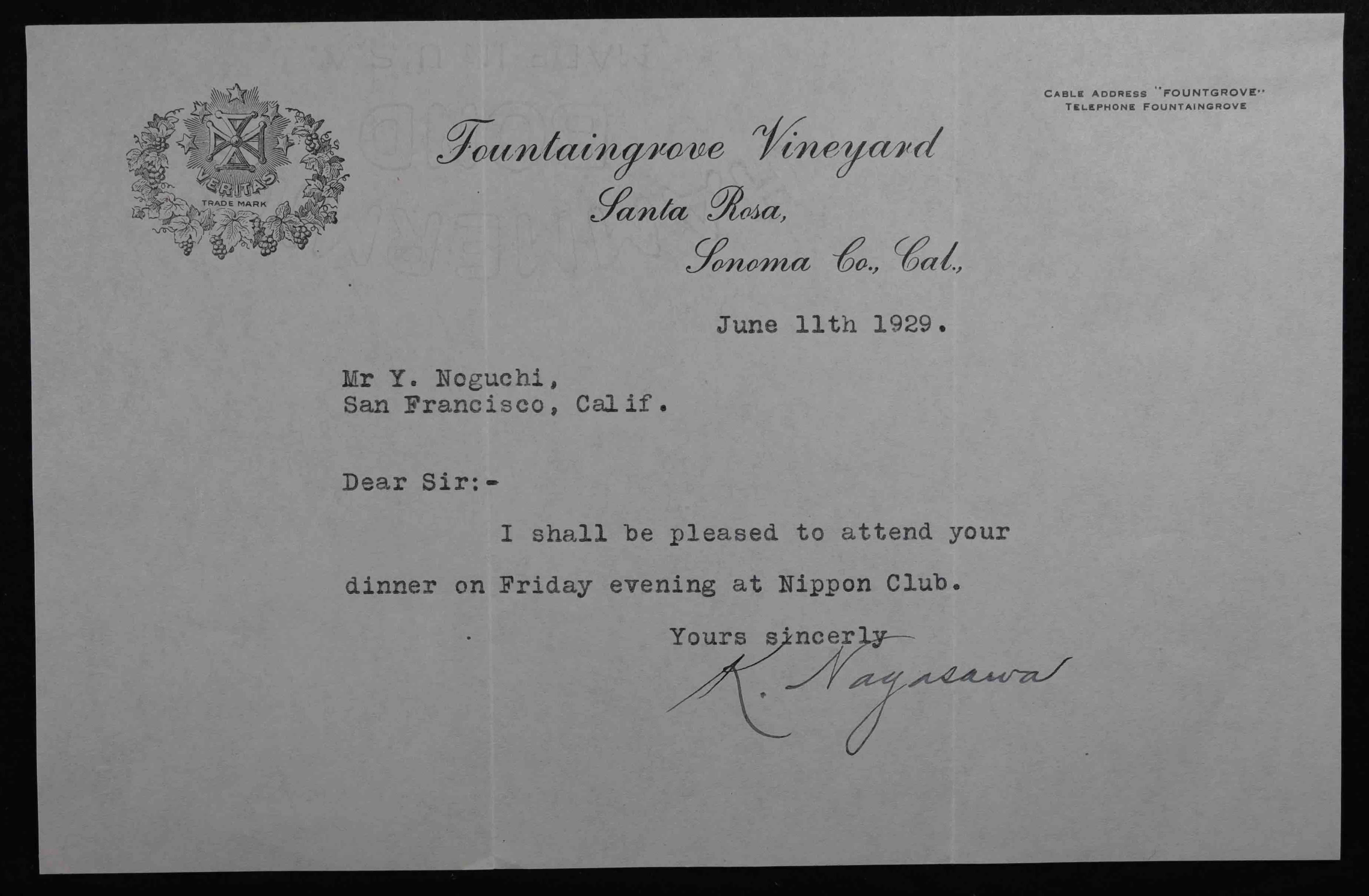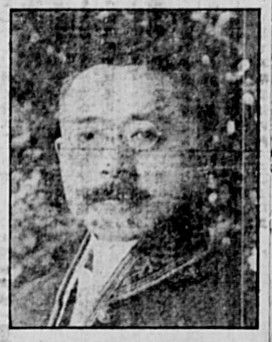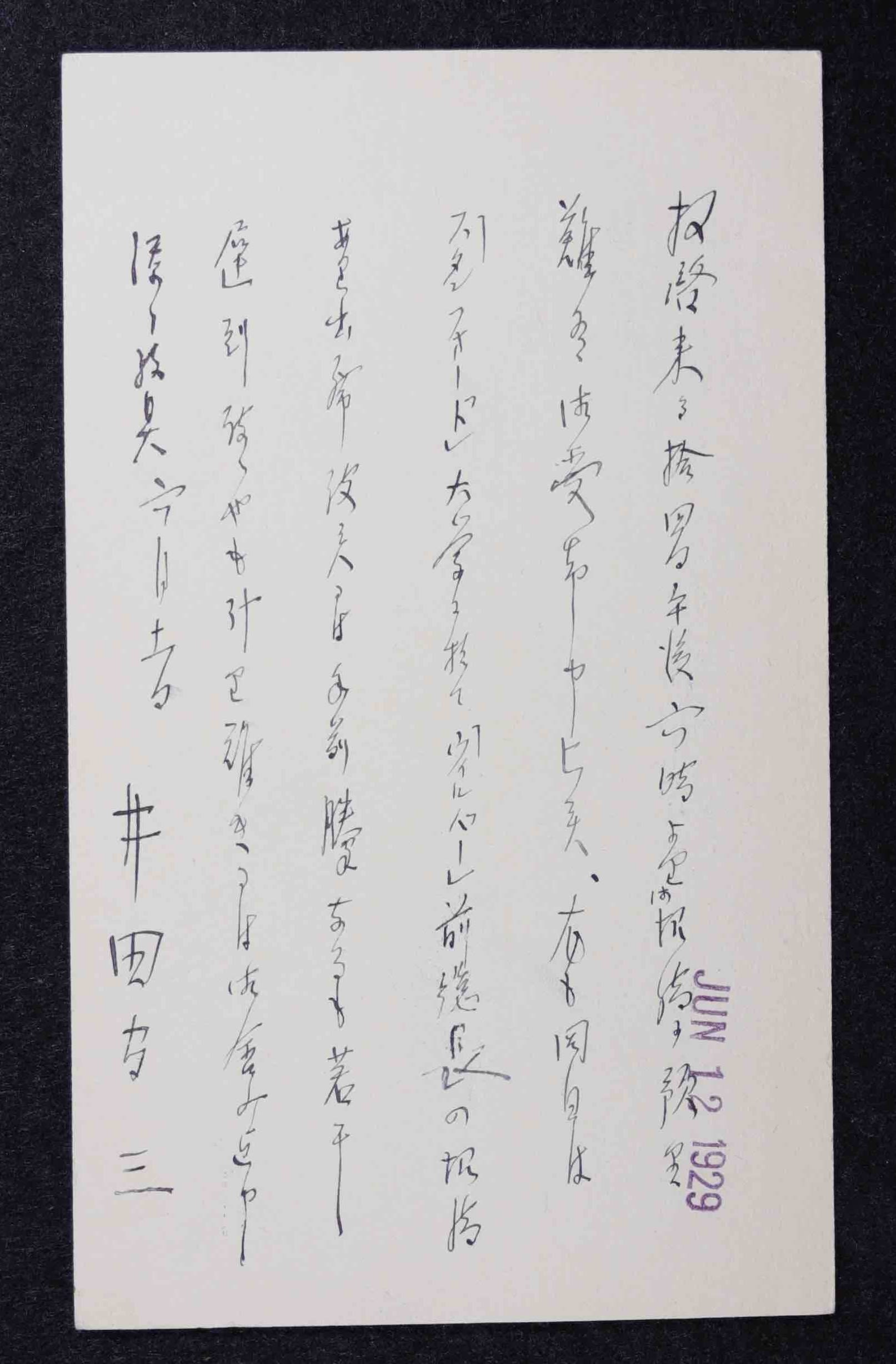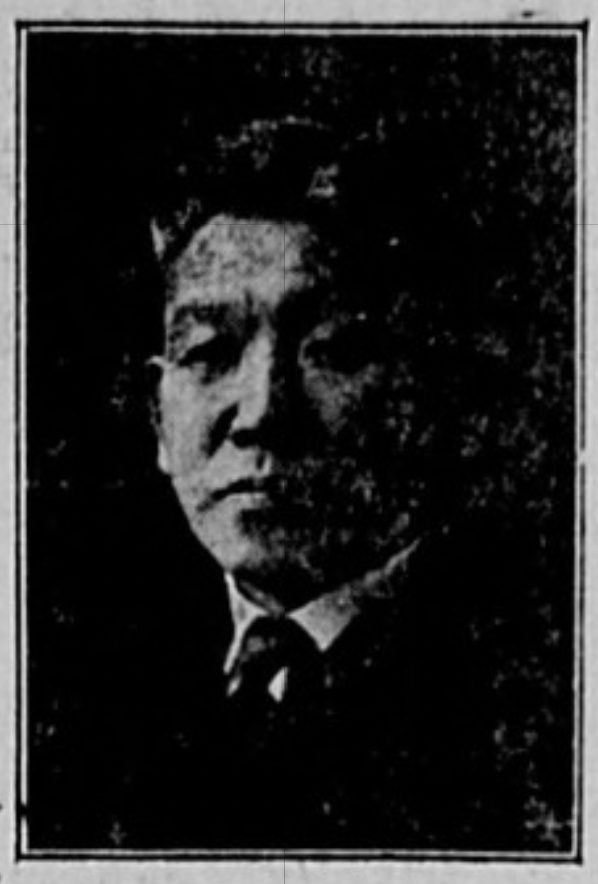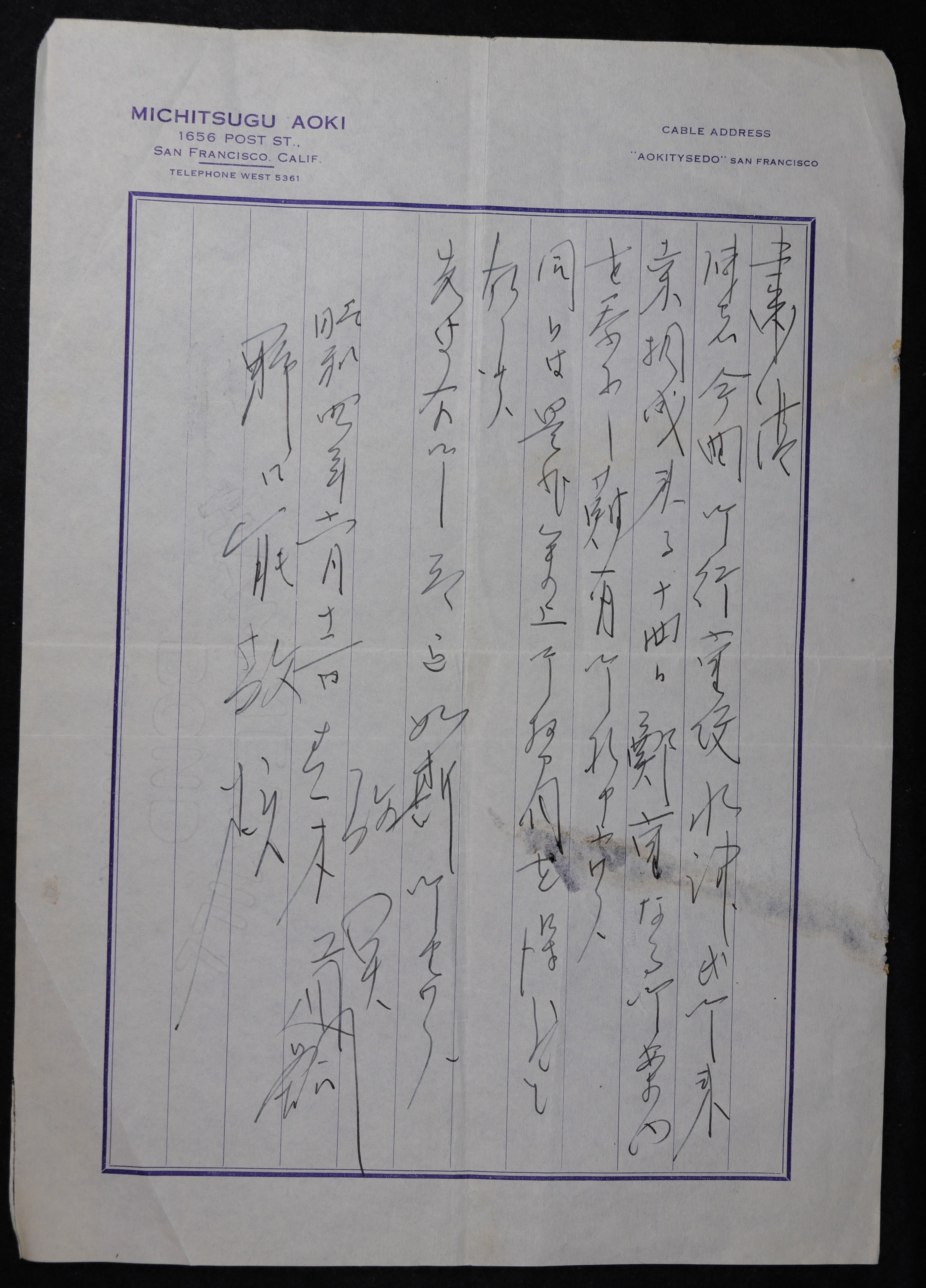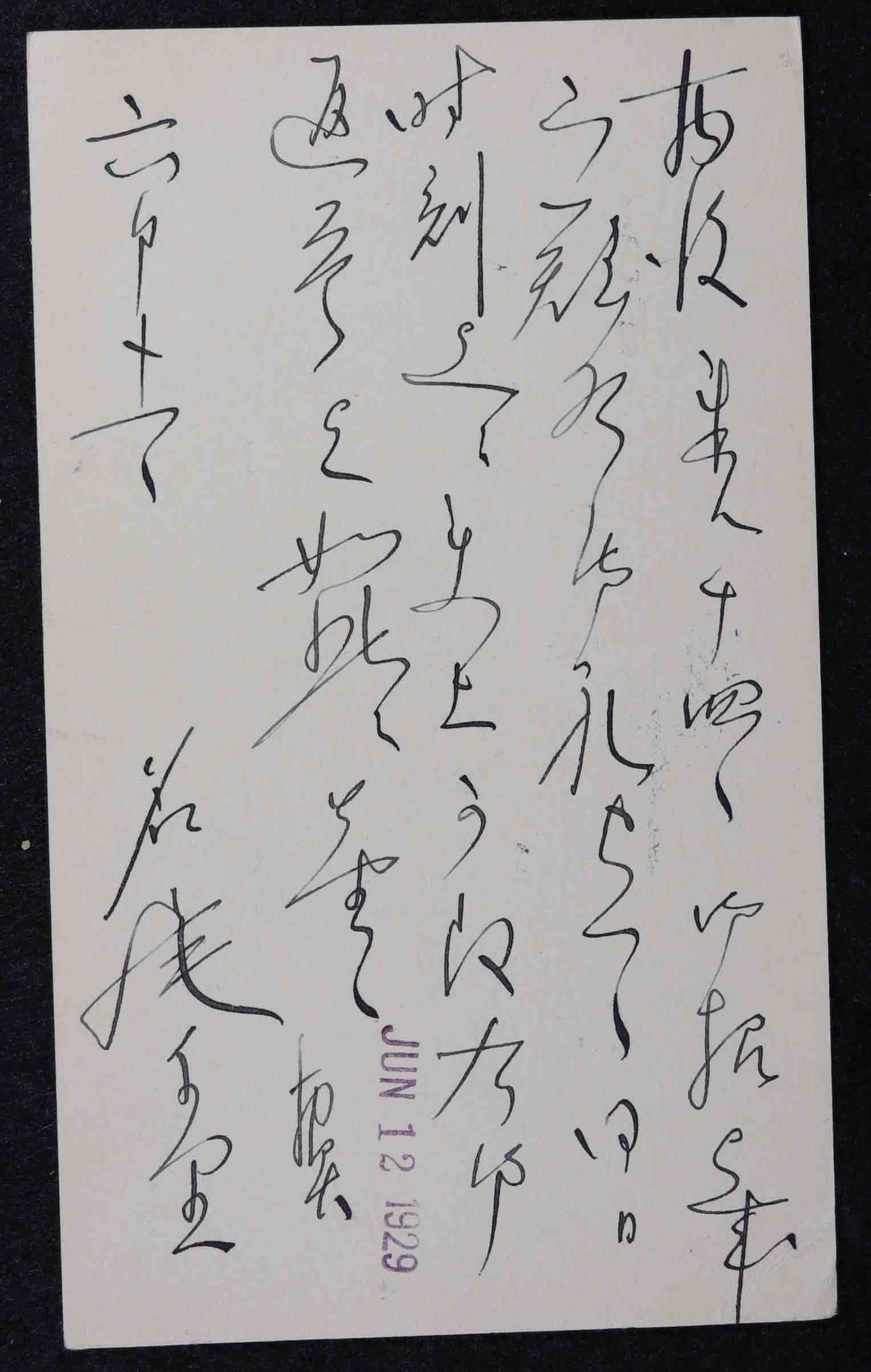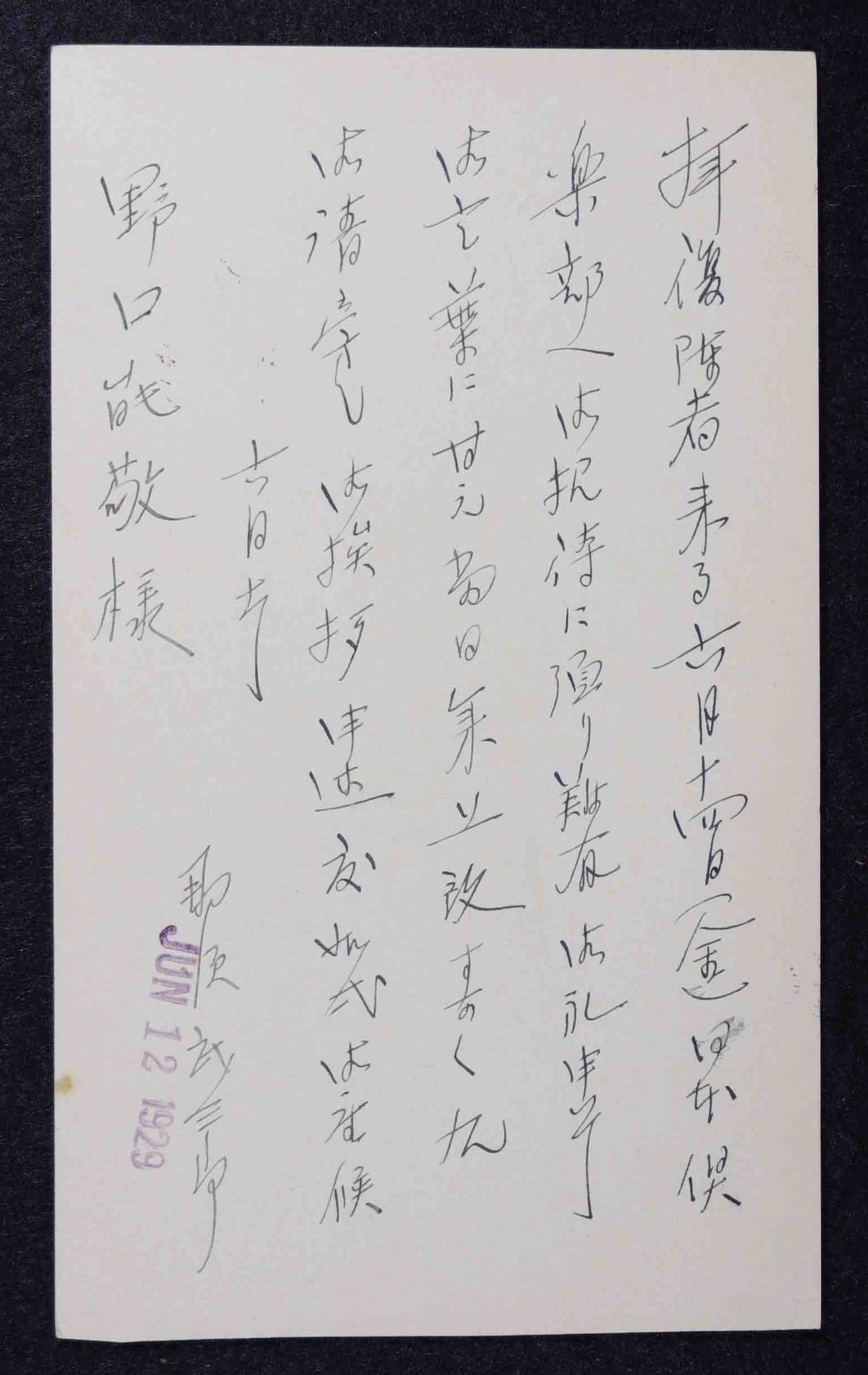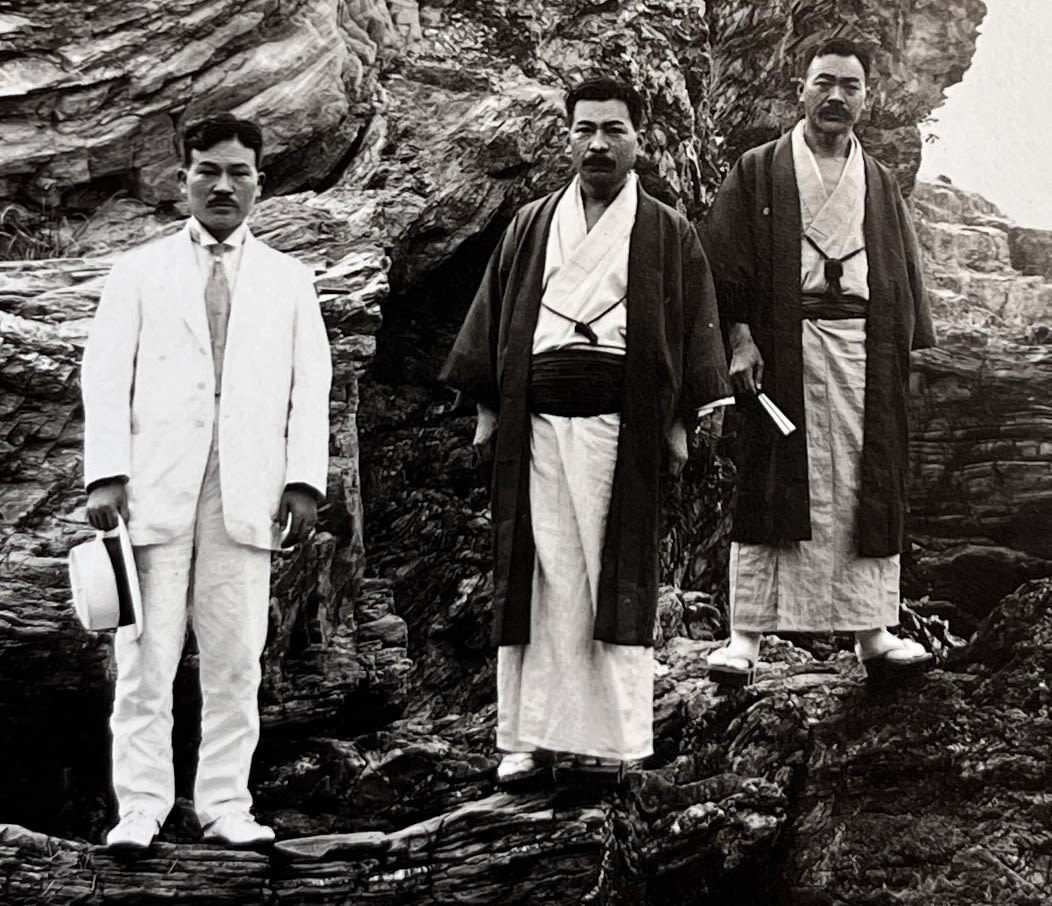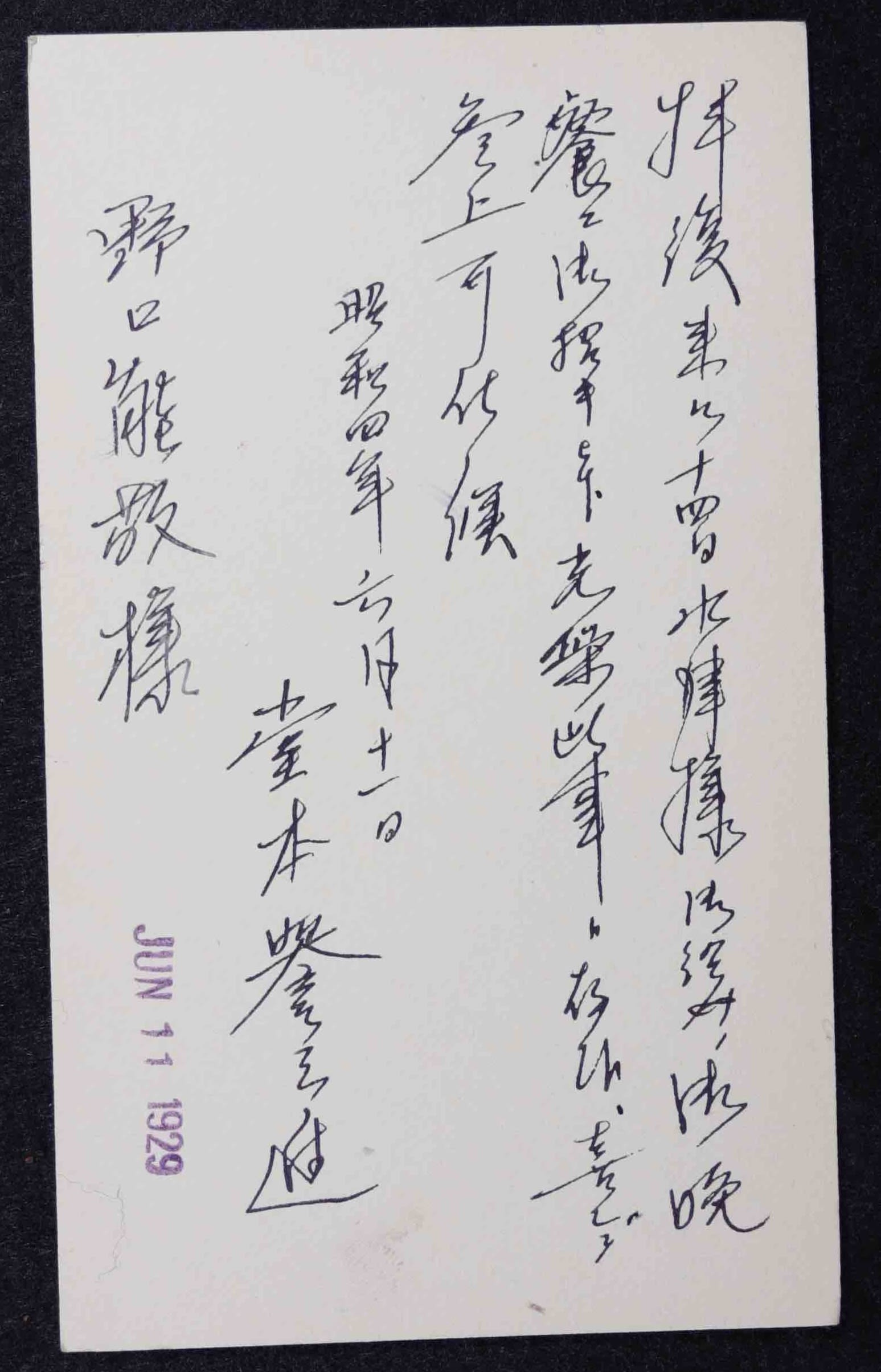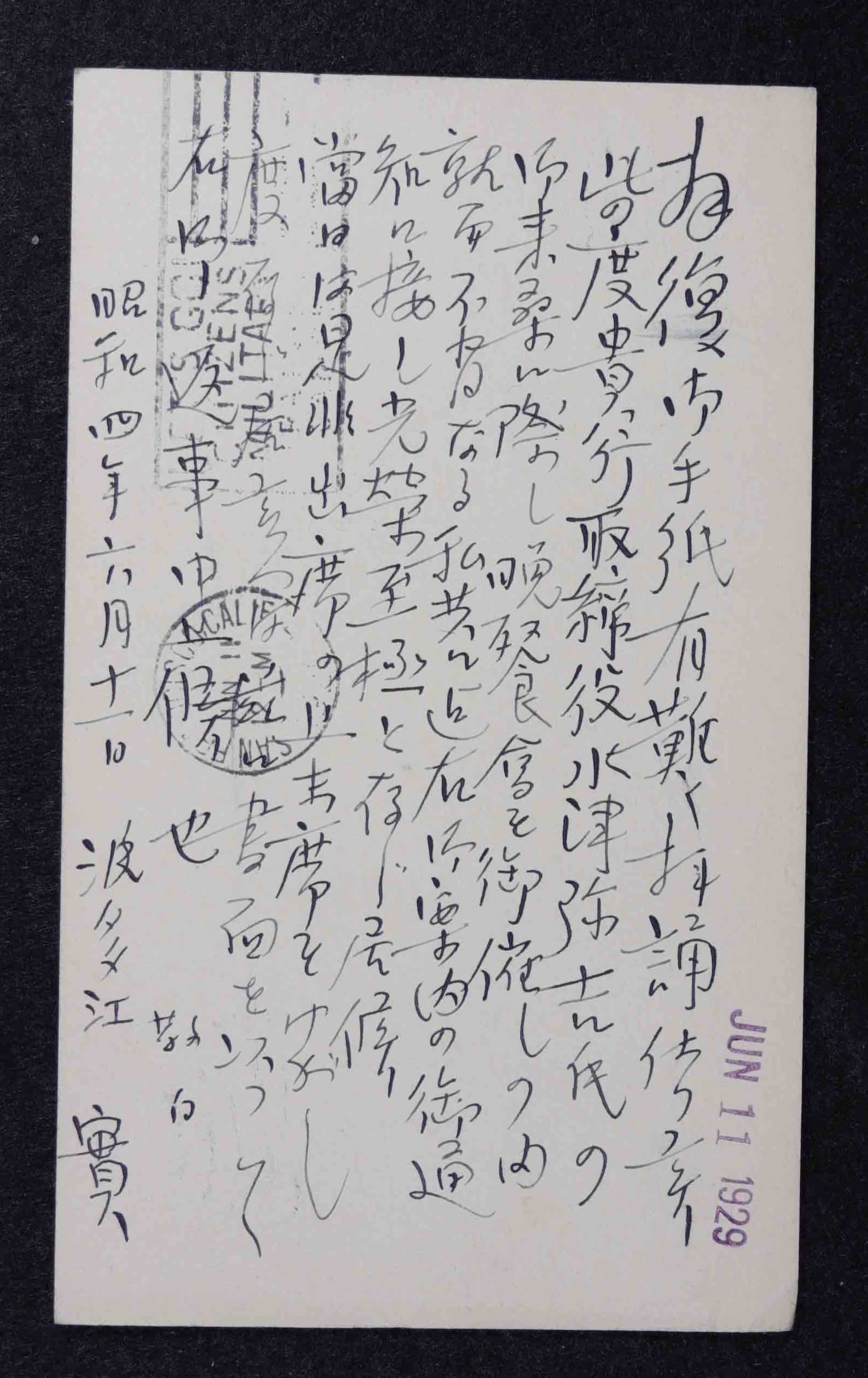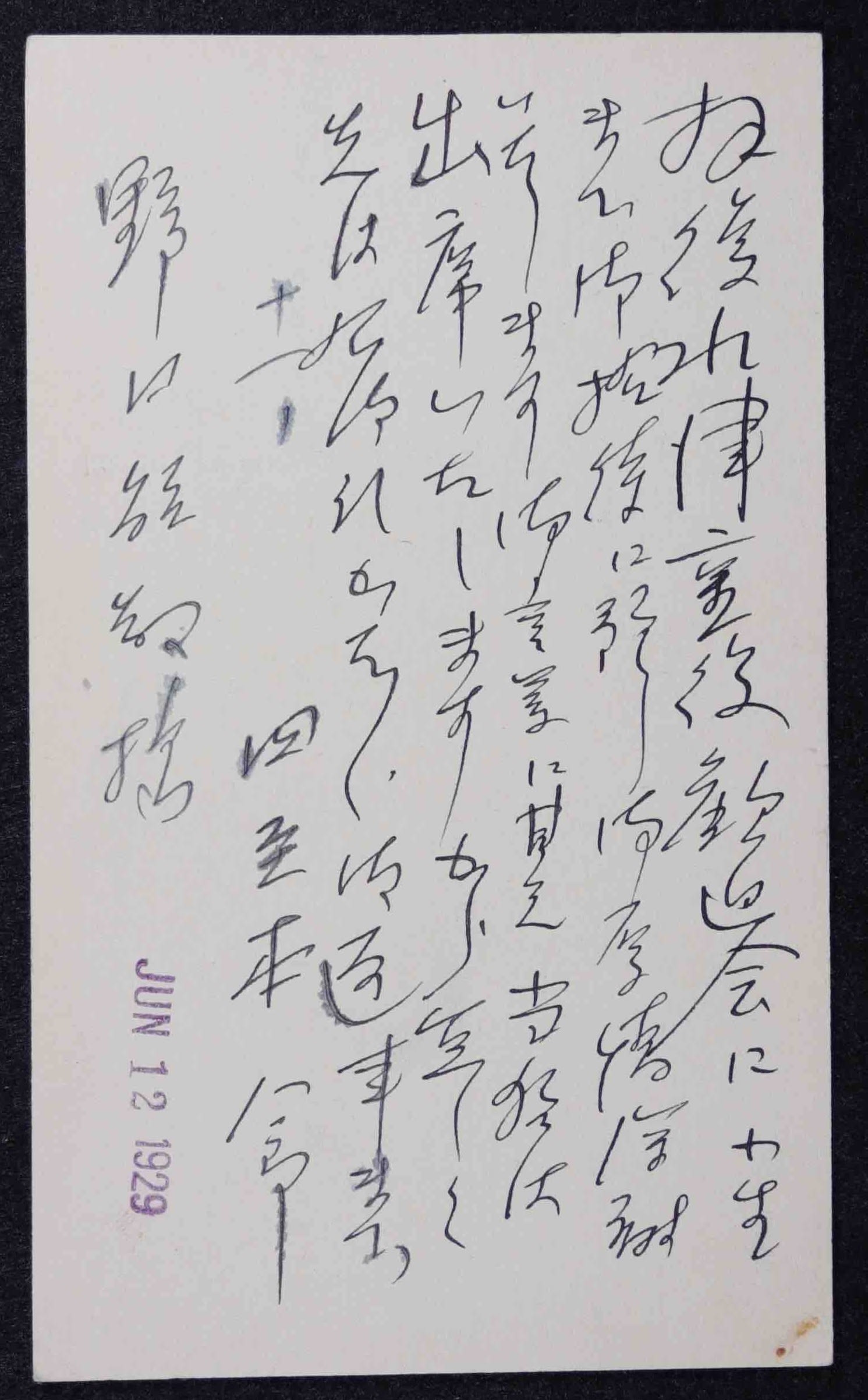Grandeur of Japanese American Society in 1929 San Francisco Bay Area
The Yokohama Specie Bank Banquet on the Eve of the Great Depression

This site is currently in beta.
We welcome your feedback and please come back for future developments.
Email us at jaha@jcccnc.org or call 415.567.5505.
On the evening of June 14, 1929, prominent Japanese American figures convened at the Nippon Club 日本倶楽部, a renowned venue for hosting both Japanese and American dignitaries, situated midway between San Francisco's bustling business district and Japantown. Over seventy invitations were extended to the crème de la crème of the Japanese American business community in the Bay Area.
The purpose of this gathering was to welcome and engage with Yakichi Mizutsu 水津 彌𠮷, an executive from the Yokohama Specie Bank (YSB) in Yokohama, Japan, who had embarked on a two-fold mission.
Zaibei Nihonjinshi / 在米日本人史, (1940, San Francisco, CA). English translation by Seizo Oka, JAHA, JCCCNC
Zaibei Nihonjinshi / 在米日本人史, (1940, San Francisco, CA). English translation by Seizo Oka, JAHA, JCCCNC
His official objective was to conduct inspections of the bank's overseas branches in Europe and North America. Simultaneously, he aimed to bolster the sales of gold from Japan, a task of no small significance. Little did anyone present that evening realize the profound global economic turbulence that lay just a few months ahead—the onset of the Great Depression, spanning from October 1929 to 1939.
On April 9, 1929, The Nichi-Bei newspaper detailed Mizutsu's upcoming voyage from Yokohama to Europe and North America. This information, relayed from Tokyo by Gōdō, implied that Mizutsu's inspection tour of overseas branches had a more significant underlying objective: to lay the groundwork for the resumption of Japan's gold export operations.
On April 9, 1929, The Nichi-Bei newspaper detailed Mizutsu's upcoming voyage from Yokohama to Europe and North America. This information, relayed from Tokyo by Gōdō, implied that Mizutsu's inspection tour of overseas branches had a more significant underlying objective: to lay the groundwork for the resumption of Japan's gold export operations.
The Banquet Guests
Business and Opinion Leaders in the Bay Area’s Japanese American Community


Of the 73 individuals who received invitations, a remarkable 59 responded with formal enthusiasm1, graciously accepting the bank's offer. The two exceptions were Kanae Nagasawa and Kiyoshi Togasaki2. The former chose to type their replies in English.
The invitees comprised the very essence of Japanese American business and opinion leadership, consisting of owners and executives of trading and newspaper companies. Although YSB's clientele extended beyond trading companies, these businesses were strategically pivotal as they played a crucial role in selling Japanese products and generating foreign currencies for Japan. Hence, notable religious leaders or educators were conspicuously absent from the guest list.
The invitees represented those considered Japanese American business and opinion leaders and the owners and executives of trading companies3. Although YSB’s clients were not limited to trading companies, they were strategically important because they sold Japanese products and earned foreign currencies for Japan. So don’t be surprised if you don’t see some well-known religious leaders or educators. In a nutshell, the banquet was a business meeting with luxurious food and sake.
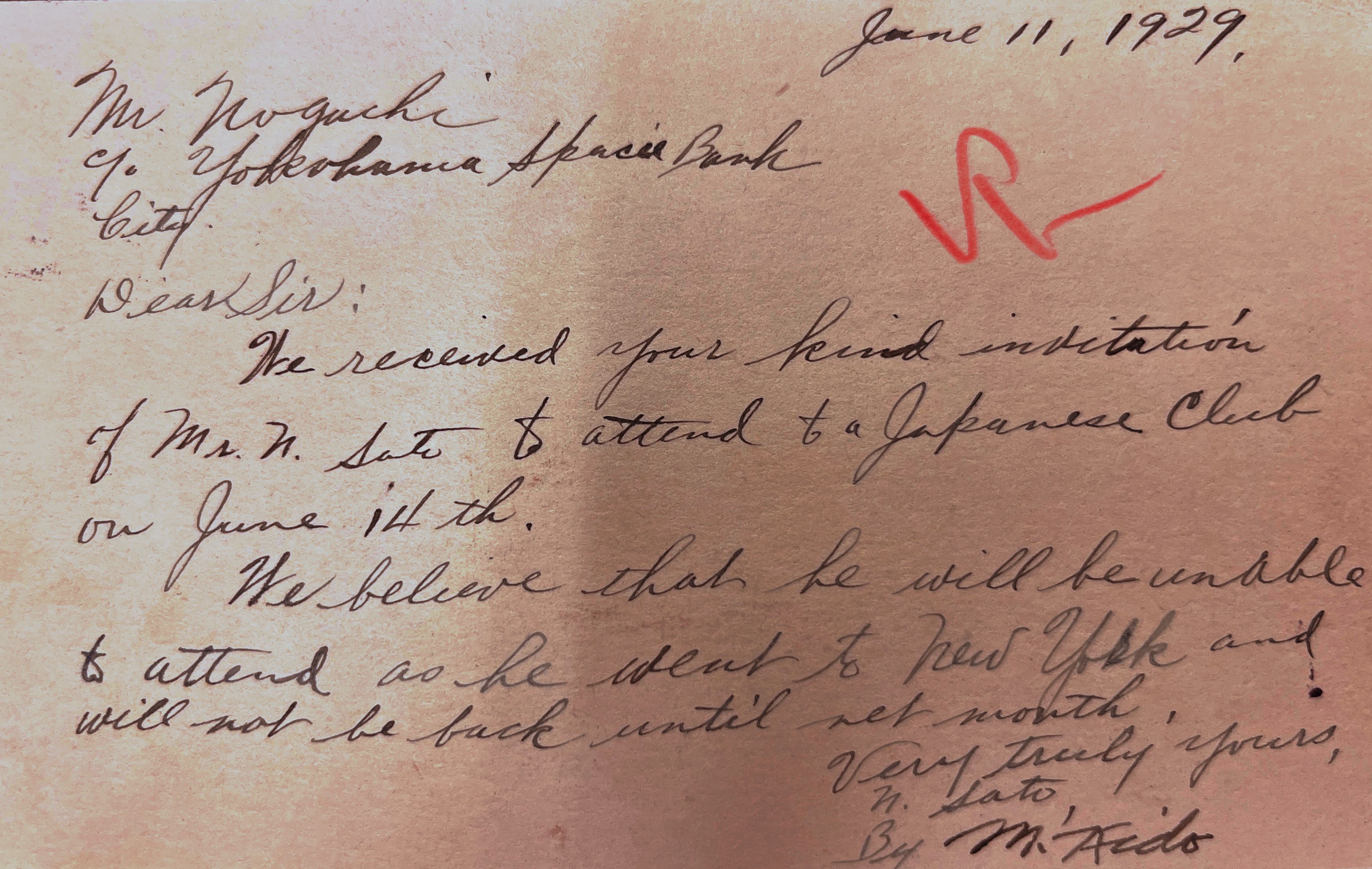


Kanae Nagasawa 長澤鼎
(1852–1934)
Kanae Nagasawa loomed in the Japanese American society, largely due to his remarkable business success at Fountaingrove Vineyard. This success extended well beyond the boundaries of the Nikkei community. Before the era of Prohibition, Nagasawa's winemaking enterprise, initially founded by a preacher, Thomas Lake Harris, and subsequently transferred to Nagasawa, ranked among California's most prominent wine producers.
Nagasawa's samurai heritage, originating from the Satsuma domain, garnered him the prestige of the Japanese American community. What set him apart, however, was his impeccable command of English, complete with a Scottish accent acquired during his formative years after leaving Japan in 1865. This linguistic prowess enabled Nagasawa to establish connections outside of the Japanese community, serving as a vital bridge to the wider American population.
Situated on an expansive 2,000-acre estate in Santa Rosa, Nagasawa's residence served as an elegant destination, where every newly arrived Japanese Consul General from San Francisco paid a customary visit.
Fountaingrove Vineyard, Museum of Sonoma County
Fountaingrove Vineyard, Museum of Sonoma County
In the context of the wine-making industry of that era, Fountaingrove held a prestigious position, being one of the six "fine small vineyards of Northern California" meticulously selected by Frank Schoonmaker & Co. in New York. These chosen vineyards included notable names like Wente Brothers in Livermore, I.M. Martini and F. Salmina in Napa, Korbel in Sonoma, and Almaden in the Santa Cruz Mountains.
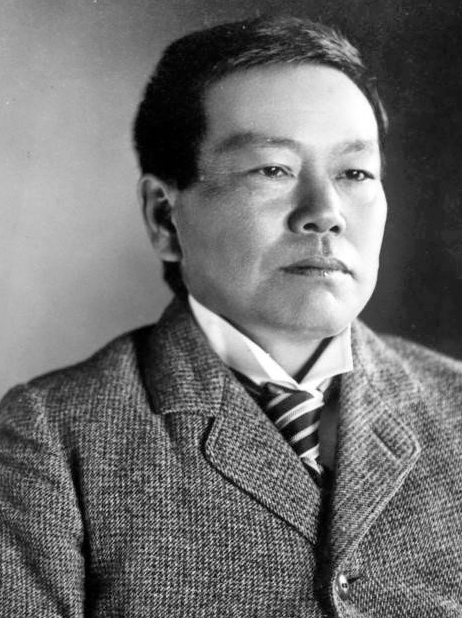
Kyutaro Abiko 安孫子 久太郎
(1865–1936)
Kyutaro Abiko 安孫子 久太郎 was a prominent opinion leader of the Japanese American society and a devout Christian. Born in 1865 in Niigata Prefecture, he ventured out to Tokyo and onto the United States in 1885. His flagship business, Nichi-Bei newspaper, was established in 1899.
Abiko's entrepreneurial endeavors extended beyond the realm of journalism. He played a pivotal role in the development of Japanese settlements, including the Yamato colony in Livingston and the Cortez colony in California. His influence reverberated far and wide, as he frequently acted as a key negotiator with the Japanese government, representing the voices of the Japanese community in America. Advocating for the permanent settlement of Japanese immigrants in America and the upholding of higher moral standards, Abiko remained a steadfast advocate for the Japanese American community.
In the tumultuous 1920s and 1930s, particularly following the enactment of the restrictive 1924 Immigration Act, Abiko turned his attention to the Nisei generation, seeking to bridge (kakehashi) connections between the United States and Japan. Abiko's legacy lives on, even after his passing in 1936. He entrusted the Nichi-Bei newspaper business to his wife, Yonako 余奈子 (1880–1944), who, notably, was a sister of Umeko Tsuda 津田 梅子, a celebrated trailblazer in Japanese women's education.
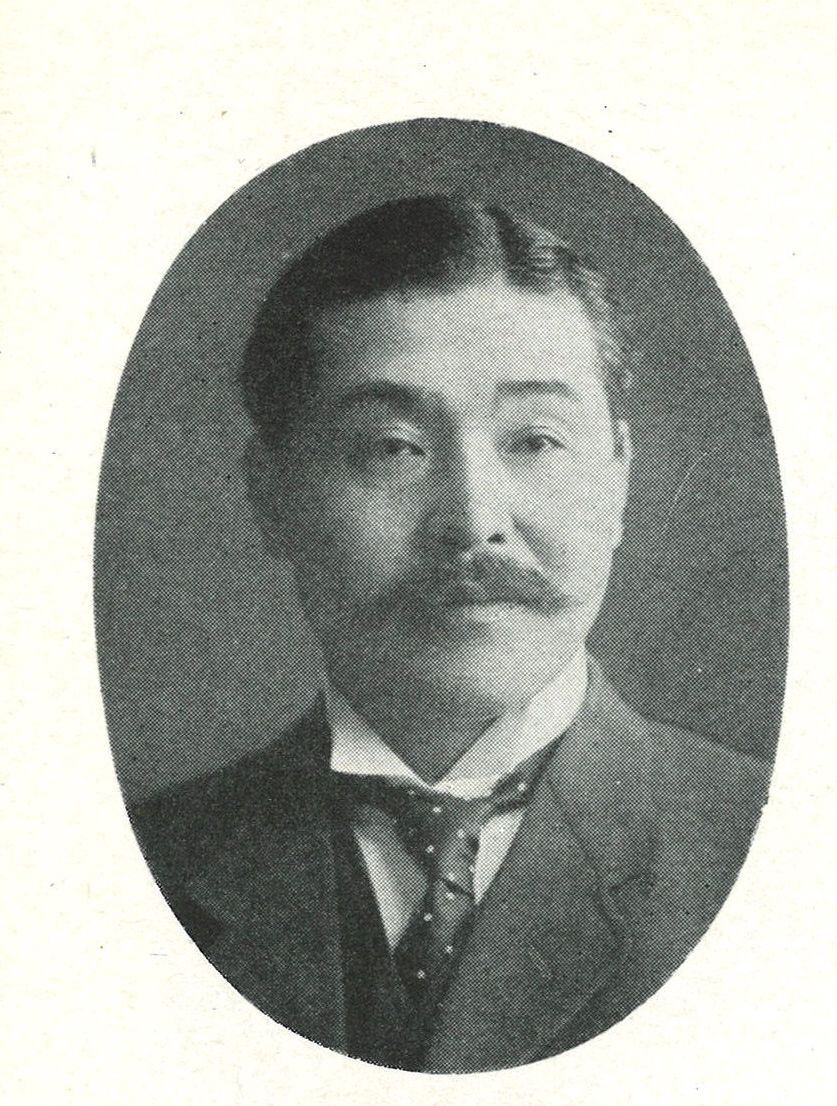
The Japanese American community in San Francisco was served by two significant newspapers: Nichi-Bei (日米新聞 Japanese-American News, 1899–1942) and Shin Sekai Shinbun (新世界新聞 The New World, 1894–1932). The latter newspaper underwent several title changes, evolving into Shin Sekai Nichinichi Shinbun (新世界日日新聞 The New World Daily News, 1932–35) and Shin Sekai Asahi Shinbun (新世界朝日新聞 The New World Sun, 1935–42) before its closure during World War II. Initially, these publications delivered much-needed global and local news in Japanese to serve the Japanese-speaking Issei. Over time, they incorporated English sections to accommodate the US-born Nisei. While the English sections were present, the Japanese-language content predominantly dominated the pages, as these newspapers served as the primary source of information for Issei, covering events from Japan to local produce market updates.
They also provided cultural platforms within their pages for both men and women, with Nichi-Bei even hosting a literature contestin 1928, featuring haikus and novels in its New Year edition. Additionally, these newspapers offered editorials addressing the issues faced by the Japanese American community, spanning language schools, immigration, land ownership, Nisei education, permanent settlement, and the guidance and shaping of community opinions.
Shin Sekai Asahi Shinbun Staff. Toyoji Abe in the middle, Iwao Kawakami to his left, and Iwao Shimizu in the far left of the second row. Iwao Shimizu Papers, Hoover Institution Library & Archives
Shin Sekai Asahi Shinbun Staff. Toyoji Abe in the middle, Iwao Kawakami to his left, and Iwao Shimizu in the far left of the second row. Iwao Shimizu Papers, Hoover Institution Library & Archives
Shin Sekai Asahi Shinbun Staff. Toyoji Abe in the middle, Iwao Kawakami to his left, and Iwao Shimizu in the far left of the second row. Iwao Shimizu Papers, Hoover Institution Library & Archives
Shin Sekai Asahi Shinbun Staff. Toyoji Abe in the middle, Iwao Kawakami to his left, and Iwao Shimizu in the far left of the second row. Iwao Shimizu Papers, Hoover Institution Library & Archives
New Year Call for Literature and Arts to be featured in the 1929 New Year edition of The Nichi Bei. Hojishinbun Digital Collection, Hoover Institution Library & Archives
New Year Call for Literature and Arts to be featured in the 1929 New Year edition of The Nichi Bei. Hojishinbun Digital Collection, Hoover Institution Library & Archives
New Year Call for Literature and Arts to be featured in the 1929 New Year edition of The Nichi Bei. Hojishinbun Digital Collection, Hoover Institution Library & Archives
New Year Call for Literature and Arts to be featured in the 1929 New Year edition of The Nichi Bei. Hojishinbun Digital Collection, Hoover Institution Library & Archives
Japan Association Council Members in San Francisco (1931), Iwao Shimizu Papers, Hoover Institution Library & Archives
Japan Association Council Members in San Francisco (1931), Iwao Shimizu Papers, Hoover Institution Library & Archives
Japan Association Council Members in San Francisco (1931), Iwao Shimizu Papers, Hoover Institution Library & Archives
Japan Association Council Members in San Francisco (1931), Iwao Shimizu Papers, Hoover Institution Library & Archives
Notably, many top journalists from these publications were invited to the 1929 banquet hosted by YSB. However, the head table bore the presence of only one, Kyutaro Abiko. It's important to note that the world of journalism was highly interconnected, with many journalists transitioning between locations globally. Hachiro Shishimoto 四至本 八郎, for instance, began his career at Tokyo Central Newspaper (Tokyo Chuo Shinbun 東京中央新聞) after graduating from Waseda University. He subsequently relocated to the United States in 1915, working at Shin Sekai before shifting to Nichi-Bei in 1919. Eventually, he returned to Japan to assume the role of director at the Newspaper Institute 新聞学院 in Japan.
While Nichi-Bei Shinbun remained under the consistent leadership of Kyutaro Abiko, its rival vernacular press, Shin Sekai, and its successor companies experienced frequent changes in leadership5. The New World, however, held particular importance for the San Francisco branch of YSB, possibly due to its closer association with the Japanese Association and, subsequently, the Japanese government6.
Furthermore, Kyutaro Abiko held a position that extended beyond YSB's control, further reinforcing the presence of New World executives at the banquet. Among these executives were Toyoji Abe 阿部豊治, the chief editor who transitioned from the presidency of the Oregon News (央州日報 Oshu Nippo) to Shin Sekai, Shintaro Hara 原 信太郎, the Oakland branch manager of Shin Sekai, and Risaku Ninomiya 二宮利作, the chief editor7. Their collective presence underscored the newspaper's importance in the Japanese American community and its alignment with the Yokohama Specie Bank's banquet.
Ko Matsuoka 松岡 興
(1881–?)
Ko Matsuoka 松岡 興, born in 1881, embarked on his journey to America in 1908. He established Atow Matsuoka Co., an "Oriental" curio store located on Grant Avenue, catering primarily to tourists. Over the years, Matsuoka made several trips from the United States to Japan, likely in pursuit of his business interests. His success was evident as he traveled first-class on transpacific voyages.
Atow Matsuoka papers, JAHA, JCCCNC
Atow Matsuoka papers, JAHA, JCCCNC
While the exact reason for the Matsuoka family's departure from San Francisco to return to Japan in 1940 remains unspecified in newspaper articles, it is conceivable that the increasing Japanese product boycott on the West Coast following the Japanese invasion of China in 1937 (as reported in the Shin Sekai Asahi Shinbun on September 7, 1940) may have taken a toll on his business, prompting this decision (Shin Sekai Asahi Shinbun, September 7, 1940 )
日本行きを嫌って突如出帆間際に下船。松岡巌君浅間丸出稿を遅らす. Iwao Matsuoka [Ko Matsuoka's second son age 16] suddenly disembarked just before setting sail, because he did not want to go to Japan. He delays the departure of the Asama Maru.
日本行きを嫌って突如出帆間際に下船。松岡巌君浅間丸出稿を遅らす. Iwao Matsuoka [Ko Matsuoka's second son age 16] suddenly disembarked just before setting sail, because he did not want to go to Japan. He delays the departure of the Asama Maru.
Atow Matsuoka papers, JAHA, JCCCNC
Atow Matsuoka papers, JAHA, JCCCNC
Atow Matsuoka papers, JAHA, JCCCNC
Atow Matsuoka papers, JAHA, JCCCNC
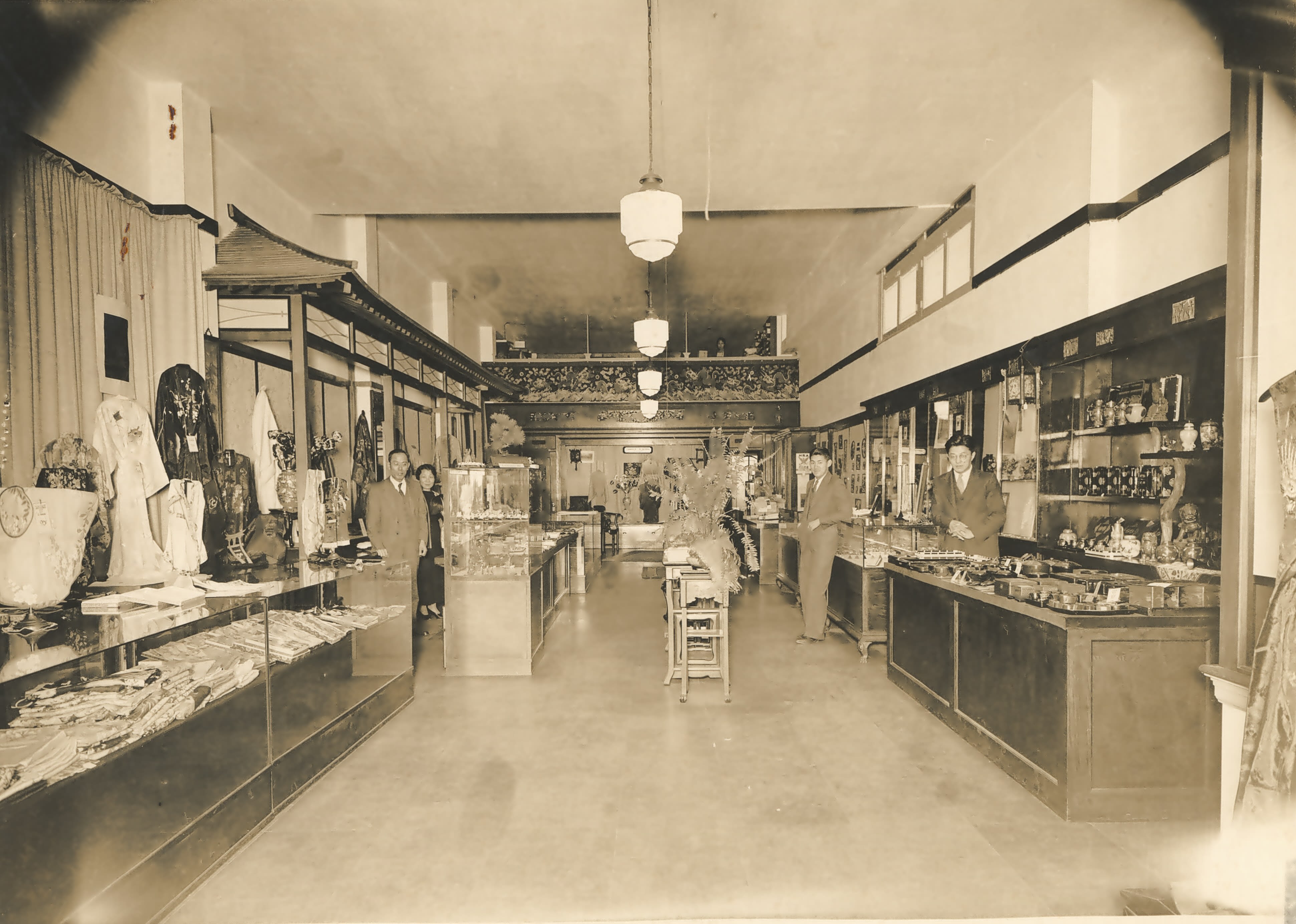
Takanoshin Domoto
堂本誉之進
(1857–1941)
Takanoshin Domoto 堂本誉之進 was the president of the North American Mercantile Company (Hokubei Boeki Kabushiki Kaisha 北米貿易株式会社) in San Francisco.
Arriving in the United States in 1884, Domoto tirelessly worked to help establish Domoto Brothers Nursery in Oakland. With innovation at the forefront, he introduced a plethora of agricultural products and seafood to the American market, contributing to the accessibility of Japanese cuisine for Issei immigrants. He made an indelible mark by importing mikan tangerines from his home province in Wakayama and introducing quintessential Japanese products like soy sauce. His innovative canned products, most notably the renowned Namco canned crab meat, became household staples across the United States, adored by countless Americans in a variety of crab-based dishes.
Domoto possessed an innate talent for marketing his products, as evidenced by his published cookbook, "Romance and Science Combine to Offer You Unsurpassed Delicacy in Namco Crab Meat." While he maintained his presence in the trading business, his brother Kanetaro 兼太郎, who also attended the banquet, embarked on a journey into the nursery industry. There, he established Domoto Brothers, sparking interest among Americans in Japanese plants. He cultivated the skills of numerous aspiring nurserymen, so his nursery business was referred to as "Domoto College."

Seating Arrangement


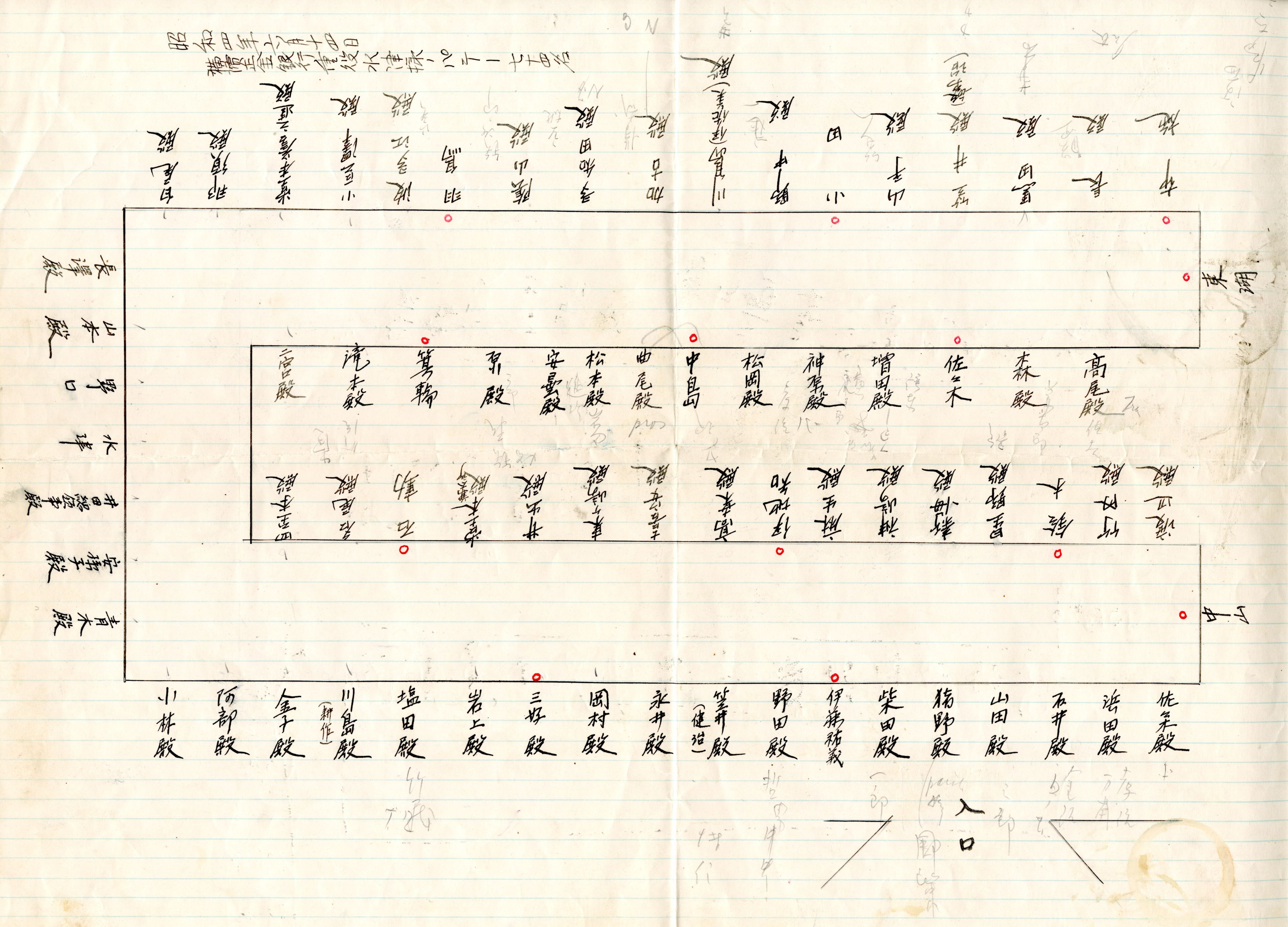
We also discovered a seating arrangement from the YSB records, providing a rare window into the influential figures of the Bay Area Japanese American society in 1929. The hierarchy is strikingly evident, with a clear division between the head table and the remaining guests.
Following Japanese tradition, a seat farthest from the entrance is referred to as "kamiza" (上座), signifying an upper seat, while the one closest to the door is termed "shimoza" (下座), a lower seat. This tradition was meticulously observed at the banquet, with the head table positioned furthest from the entrance. Closer to the entrance, you could find junior attendees, including Nagasawa's nephew Eikichi Sasaki 佐々木 英吉 and Kojiro Hamada 浜田 幸次郎, an employee of Banzai Trading 萬歳貿易商会 at the San Francisco branch.
Seated at the head table, from left to right, were Kanae Nagasawa, Takeo Yamamoto 山本 武夫 of NYK Line 日本郵船株式会社, Yoshinori Noguchi 野口能敬, the San Francisco branch manager of YSB, the guest of honor Mizutsu, San Francisco Consul General Morizo Ida 井田 守三, Kyutaro Abiko, and Michitsugu Aoki 青木 道嗣, the chairman of the Japanese Association and owner of Taiseido 大成堂.
Kanae Nagasawa 長澤鼎 (1852–1934)
Kanae Nagasawa 長澤鼎 (1852–1934)
Kanae Nagasawa's reply card, YSB records, JAHA Archives, JCCCNC.
Kanae Nagasawa's reply card, YSB records, JAHA Archives, JCCCNC.
Transcription
June 11, 1929
Mr. Y. Noguchi San Francisco, Calif.
Dear Sir, I shall be pleased to attend your dinner on Friday evening at Nippon Club.
Yours sincerely
K. Nagasawa
Translation
1929年6月11日
カリフォルニア州 サンフランシスコ
N. ノグチ
様 拝啓 金曜日の夜、日本クラブでの夕食会に出席させていただきます。
敬具
K. ナガサワ
Takeo Yamamoto 山本 武雄 of NYK Line 日本郵船株式会社
Yamamoto reply card. YSB records, JAHA Archives, JCCCNC
Yamamoto reply card. YSB records, JAHA Archives, JCCCNC
Transcription
拝復
来る金曜日は御招 待に預り難有御礼申上候
御予刻迄に参趨可致
右御礼迄 敬具
十二日
山本武夫
Translation
Dear Sir, thank you very much for the invitation for Friday. I can arrive at the scheduled time. I thank you as above. Sincerely yours
Takeo Yamamoto
Yoshinori Noguchi 野口能敬, the San Francisco branch manager of YSB
San Francisco Consul General Morizo Ida 井田 守三, Hoji Shinbun Digital Collection
San Francisco Consul General Morizo Ida 井田 守三, Hoji Shinbun Digital Collection
Ida's reply card, YSB records, JAHA Archives, JCCCNC
Ida's reply card, YSB records, JAHA Archives, JCCCNC
Transcription
拝啓 来る拾四日午後六時よりは御招待に預り
難有御受け申し上候、尤も同日は
「スタンフォード」大学に於て「ウィルバー」
前総長の招待
あり出席致し候に付、手前勝手なるも若干
遅刻致候やも計り難きに付、御含み迄申し
候 敬具 六月十一日 井田守三
Translation
Dear Sir, I would like to accept your invitation to attend the meeting at 6:00 p.m. on the 14th of June. Coincidentally, I will attend President Wilbur's invitation to Stanford University. Therefore, please forgive me for arriving a little late. June 11th, Morizo Ida
Kyutaro Abiko 安孫子 久太郎
Kyutaro Abiko 安孫子 久太郎
Abiko's reply card, YSB records, JAHA Archives, JCCCNC
Abiko's reply card, YSB records, JAHA Archives, JCCCNC
Transcription
拝啓 今回貴行取締役
水津彌吉殿御来桑に就き
野口支店長殿より
来る十四日(金曜日)午後六時に
日本倶楽部に於て晩餐之
御丁重なるご招待に預かり
奉深謝候、
⚫︎⚫︎社用にて羅府出張中に
御座候へ共十四日朝⚫︎⚫︎
つき多分御受参上致し得べく存じ
居候、猶十四日午前に今一應
御確答可申上候、先は取敢へず
右御返事迄 敬具
日米新聞社
六月十二日 安孫子久太郎
代理
Translation
Dear Sir, I would like to express my sincere appreciation for your kind invitation to a dinner party for the occasion of the Director of your bank, Mr. Yakichi Mizutsu's visit to San Francisco at the Japan Club at 6:00 p.m. on Friday, the 14th. I am sorry to inform you that I am currently in Los Angeles for business so I will not know until the end of the 14th. I will reply to you on the morning of the 14th.
Sincerely yours,
on behalf of Kyutaro Abiko, Nichibei Shinbun, June 12.
Michitsugu Aoki 青木 道嗣
Michitsugu Aoki 青木 道嗣
Aoki's reply card, YSB records, JAHA Archives, JCCCNC
Aoki's reply card, YSB records, JAHA Archives, JCCCNC
Transcription
粛復
陳者今回御行重役水津氏御来
桑相成、来る十四日鄭重なる御案内
を忝ふし難有御礼申上け候
同日は是非参上御拝伺を得度と
存じ候
先は右御礼迄、如斯御座候
敬具
昭和四年六月十二日
青木道嗣
野口能敬様
Translation
Dear Mr. Yoshinori Noguchi,
I would like to thank you for your cordial invitation to see Mr. Mizutsu, the executive director of your bank, on the 14th. On that day, I believe that I should be able to schedule to be present.
Sincerely yours
November 12, Showa 4 (1929)
Michitsugu Aoki
Hosaku Shirao 白尾豊策
Sumitomo Bank, San Francisco Branch Manager
Hosaku Shirao's reply card , YSB records, JAHA Archives, JCCCNC
Hosaku Shirao's reply card , YSB records, JAHA Archives, JCCCNC
Transcription
拝復
陳者来る拾四日日本倶楽部に
於ける御晩餐ニ御招待を辱⚫︎⚫︎
御芳志奉萬謝候
当夜ハ是非参上仕り末席を汚し
度くと存居り
右御礼旁御返事申上候
六月十一日 白尾豊策
Translation
Dear Sir, I am humbled to receive your invitation to dinner at the Japan Club on the coming 14th of October. I thank you for your kind offer. I would be humbled to attend that evening. I would like to reply as such.
June 11th Hosaku Shirao
Takesaburo Nasu 那須 武三郎
Branch Manager at Mitsubishi Shoji Kaisha in San Francisco
Nasu's reply card, YSB records, JAHA Archives, JCCCNC
Nasu's reply card, YSB records, JAHA Archives, JCCCNC
Transcription
拝復拙者来る六月十四日(金)日本倶楽部へ御招待に預り難有御礼申し候 御言葉に甘え当日参上致す可く候 御清虔し御挨拶申述為●●御●候 六月十一日 那須武三郎 野口能敬様
Translation
Mr. Yoshinori Noguchi
I would like to thank you for the invitation to the Japan Club on Friday, June 14th. I would like to take your kind words that I will be there on the day. I am pleased to accept your kind invitation and to offer my greetings.
June 11, Takesaburo Nasu
Near the head table, but at an extended U-shaped arrangement, Takanoshin Domoto 堂本誉之進 (1857–1941) sat.
Domoto brothers, 1917. Stanford Special Collections
Domoto brothers, 1917. Stanford Special Collections
Takanoshin Domoto's reply card. YSB records, JAHA Archives, JCCCNC
Takanoshin Domoto's reply card. YSB records, JAHA Archives, JCCCNC
Transcription
拝復来る十四日水津様御昇進ノ御晩餐に御招キ預 光栄此事と存じ喜び参上可仕候
昭和四年六月十一日 堂本譽之進
野口能敬様
Translation
Mr. Yoshinori Noguchi I am honored and pleased to be invited to attend Mr. Mizutsu’s promotion dinner on the 14th.
June 11, Showa 4 (1929)
Takanoshin Domoto
Minoru Hatae 波多江 實
Business owner
Hatae's reply card, YSB records, JAHA Archives, JCCCNC
Hatae's reply card, YSB records, JAHA Archives, JCCCNC
Transcription
拝復 御手紙有難く拝誦仕り候
此の度貴行取締役水津弥吉氏の
御来桑に際し晩餐会を御催しの由
就而不肖なる私共に迠右御案内の御通
知に接し光榮至極と存じ居候 當日は是非出席の上末席をけがし
度存じ居候へば⚫︎(茲ヵ)に書面を以って
右御返事申上候也 敬白
昭和四年六月十一日 波多江 實
Translation
Dear Sir, I am very pleased to read your letter and thank you for your kind invitation to a dinner party for Mr. Yakichi Mizutsu, Director of your bank, on the occasion of his visit to San Francisco. I’m extremely honored to be notified of the invitation. I would like to reply in writing that I will humbly attend the dinner. Hiroshi Hatae, June 11, Showa 4 (1929)
Kanetaro Domoto. Photo of Domoto brothers, 1917. Stanford Special Collections
Kanetaro Domoto. Photo of Domoto brothers, 1917. Stanford Special Collections
Hachiro Shishimoto 四至本 八郎
Chief Editor, Nichi Bei Shinbun, San Francisco Branch
Shishimoto reply card, YSB records, JAHA Archives, JCCCNC
Shishimoto reply card, YSB records, JAHA Archives, JCCCNC
Transcription
拝復 水津重役歓迎会に小生まで御招待に預かりご厚情感謝いたします 御言葉に甘え当日は出席いたしますから宜しく 先ずは有り難くお返事します 十一日 四至本八郎 野口能敬様
Translation
Dear Mr. Yoshinori Noguchi I would like to thank you for your warm-hearted invitation to the welcome party for Mizutsu, your executive director. I will humbly attend on that day. I thank you in reply to your invitation.
11th, Hachiro Shishimoto
Matsuoka (Atow Matsuoka), 松岡 興 the ninth from left row 2.
Matsuoka's reply card, YSB records, JAHA Archives, JCCCNC
Matsuoka's reply card, YSB records, JAHA Archives, JCCCNC
Transcription
拝復 御招待に預り奉職
同日参上可仕候
六月十一日
松岡興
Translation
Dear Sir, On the occasion of your invitation, I serve to attend on that day. June 11th, Ko Matsuoka
Toko 東湖, YSB New York branch manager, occupied the far end of the table, while YSB San Francisco branch staff were interspersed among the guests, as indicated by the small red dots on the seating chart.
Food & Sake
The 10-course menu



The ten-course menu, even by contemporary standards, exuded opulence. Commencing with a delicate clear soup (suimono), it continued with a symphony of flavors – sashimi, a refreshing vinegared dish (sunomono), a dish simmered and sweetened to perfection (amani), succulent salt-grilled crucian carp, and lobster paired with mashed green peas. The indulgence didn't stop there; it extended to chicken teriyaki and asparagus, accompanied by miso soup and rice. To conclude the culinary feast, there were sweet cantaloupe fruits and a selection of desserts served with tea.
Remarkably, the attendees managed to empty a staggering 239 [tokkuri] bottles of sake. Assuming that the bank staff did not drink much, this would be equivalent of nearly 4 bottles per invitee, a quintessential Japanese banquet!4
The total cost, including flowers to adorn the table and female entertainers, most likely geisha, was $448. To put this into perspective, in 2023, this sum would be equivalent to approximately $8,487.
Where did they come from?


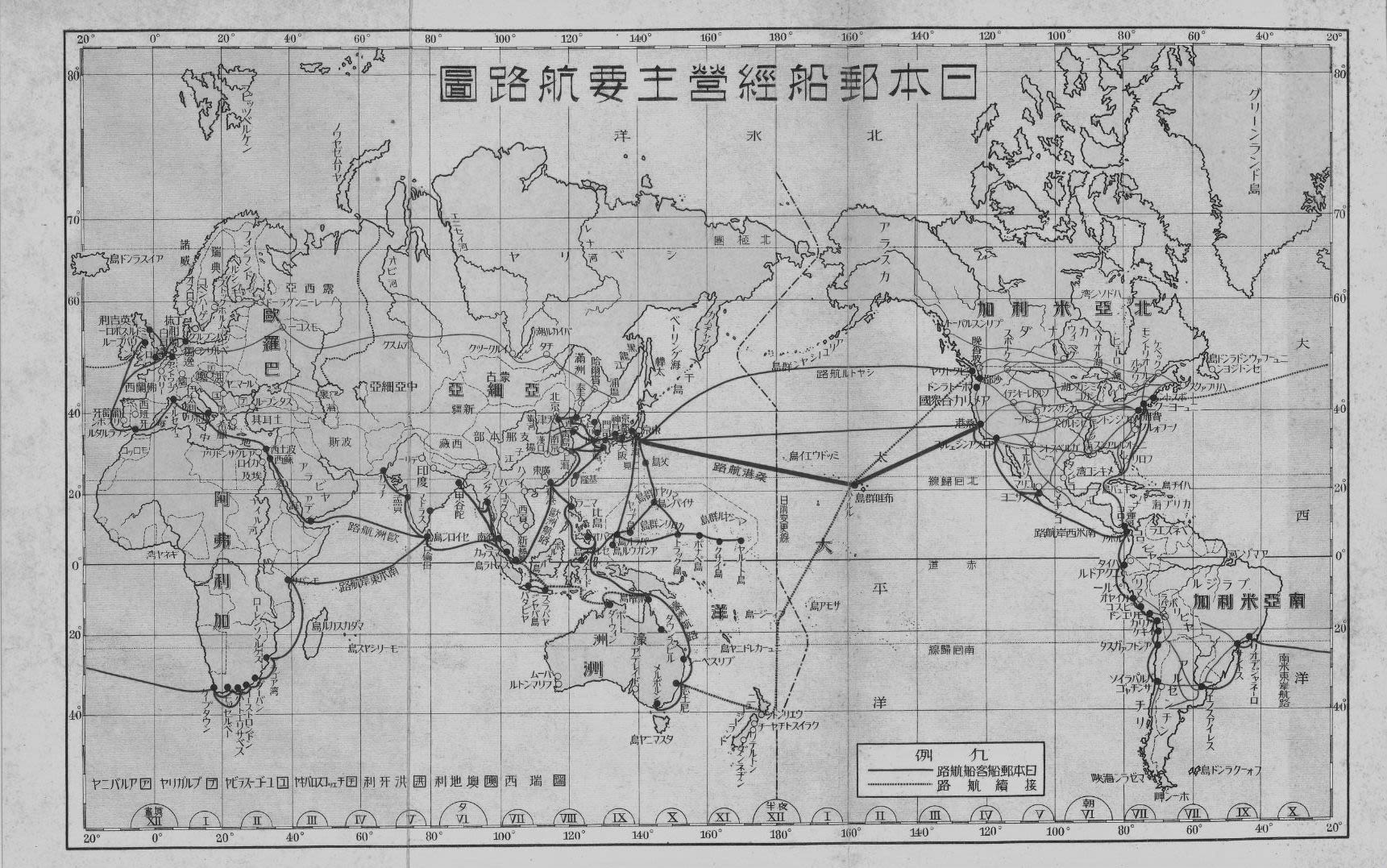
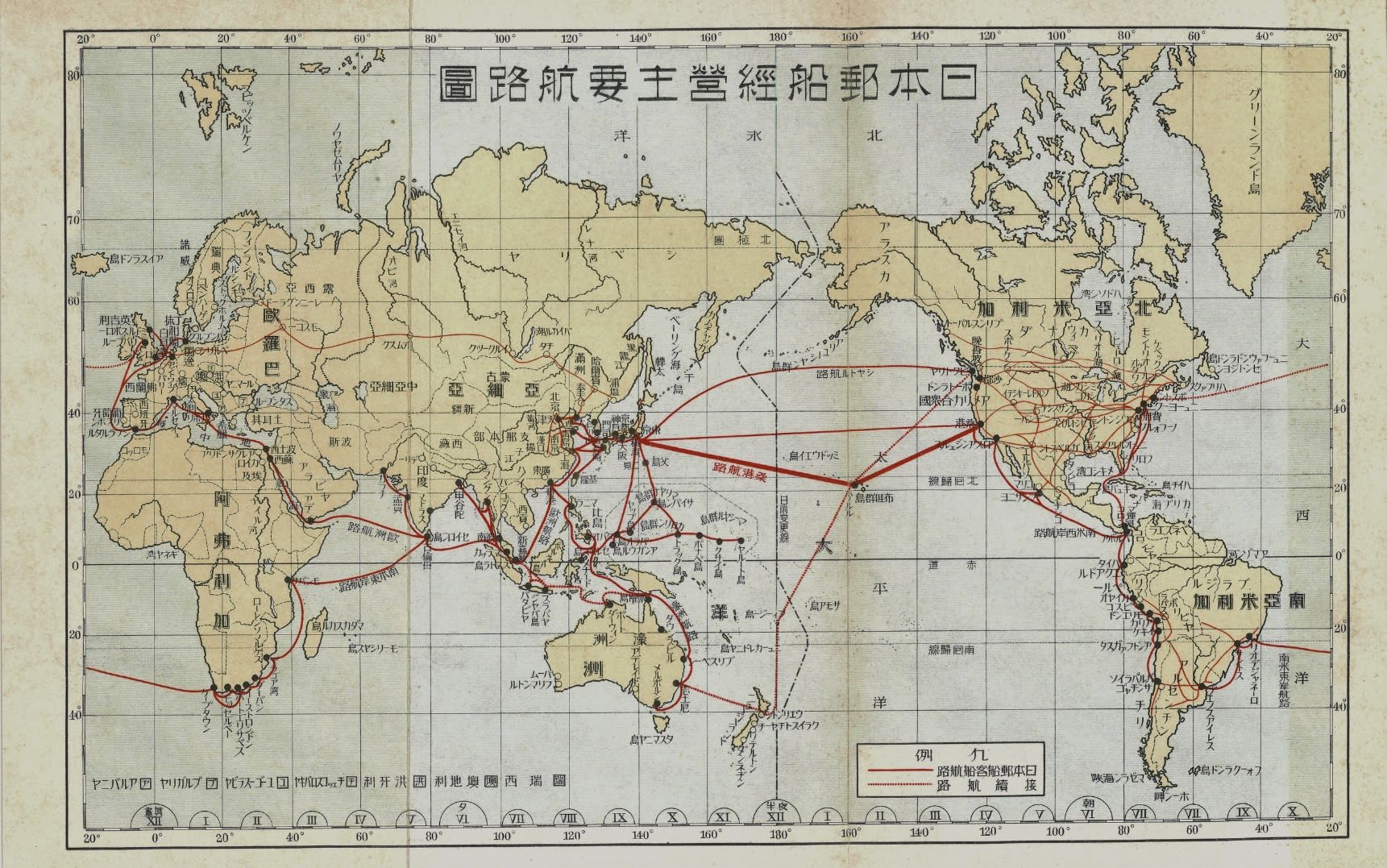

San Francisco served as the inaugural gateway to the mainland United States for a significant number of early Issei immigrants. Facilitating this pivotal connection was the Nippon Yusen Kabushiki Kaisha (NYK Lines), a prominent Japanese shipping company that transported both immigrants and export commodities from Yokohama, Japan, to San Francisco via a stop in Hawaii (as depicted on the red NYK Lines map in the background).
In contrast to the typical Japanese American immigrants, who often hailed from regions like Hiroshima and Yamaguchi, the Japanese American invitees to the 1929 banquet had diverse origins across various prefectures in Japan. Strikingly, only one individual, Tetsuo Noda of the San Francisco Central Commercial Company, came from Hiroshima, and none had their roots in Yamaguchi. The attendees were primarily urban dwellers, deeply involved in trade, finance, and journalism, with the exception of Nagasawa and Kanetaro Domoto. Their response cards revealed a high level of Japanese education, with many venturing to the United States individually, driven by the pursuit of education, business opportunities, or personal adventures.
Map of Banquet Attendees
Navigate this interactive map to uncover the rich geographical connections among the banquet attendees of the YSB banquet in 1929. Delve into the three layers of the map: discover the locations where they conducted business, explore the neighborhoods they called home, and trace their roots to the heart of Japan.
This map, produced in Google Maps, is crafted using data from the 1929 日米年鑑 (Japanese American Directories) for U.S. addresses and the 1922 在米日本人人名辞典 (Who's Who of Japanese in America) for insights into their Japanese origins.
Each pin and icon on the map is a gateway to a personal narrative, offering a glimpse into their lives and providing access to their brief bios, reply cards, transcriptions, translations, and historical sources of information.
|
|
INSTRUCTIONS: |
The Japanese American residential area was well-established by the time of banquet, ecompassing from Grant to Stockton, South Park, and so-called an upper Japantown district, with a central focus around Post and Buchanan Streets. This expanded area extended from Octavia Street in the east to Filmore Street in the west, O’Farrell Street in the south, and Pine Street in the north.
Guide to Bow-Chow hotel, Japanese Diaspora collection, Hoover Institution Library & Archives
Guide to Bow-Chow hotel, Japanese Diaspora collection, Hoover Institution Library & Archives
To reach Bow-Chow Hotel, depart from the Third Street depot, proceed toward Marker Street for one and a half blocks, and make a right turn, where you will encounter a signboard of the recently built Bow-Chow Hotel.
The Japanese American residents invited to the 1929 banquet tended to be more centrally located, primarily within the boundaries of Pine and Geary Streets, and Laguna and Webster Streets. It's worth noting that not all Japanese Americans resided within Japantown. An intriguing exception was Kyutaro Abiko, who lived in Presidio Heights. The addresses of many Japanese ex-pats are not usually recorded in the directories, so it’s unclear where they lived. However, whosever addresses recorded in the directories were more scattered than the long-term Japanese American residents.
A fascinating correlation existed between geographical locations and social positioning. Japanese American organizations, such as the Japanese Association, clustered in the heart of Japantown. The Nippon Club, the chosen venue for the 1929 banquet, occupied a strategic position between the bustling business district and the Japantown, mirroring its geographical and social bridge between the two worlds.
The YSB records within the JAHA collection provide a unique and intimate perspective on the inner workings of the Japanese American community in San Francisco in 1929. These records offer a wealth of intricate details about the banquet, revealing aspects that would remain concealed in a sanitized history book. This documentation includes the comprehensive list of invitees, a meticulously arranged seating chart, reply cards inscribed by the invitees, the elaborate meal menu, and even insights into alcohol consumption—an authentic window into the past.
The records of the Yokohama Specie Bank's (YSB) San Francisco branch, currently housed in the Japanese American Historical Archives - Seizo Oka Collection (JAHA) at the Japanese American Cultural Center of Northern California (JCCCNC), provide a unique window into the inner workings of the Japanese American business community. This aspect of history is often overlooked in traditional historical accounts, offering a nuanced understanding of the Japanese American community, its intricate social networks, hierarchical structures, business objectives, and entertainment activities during the era of prohibition.

